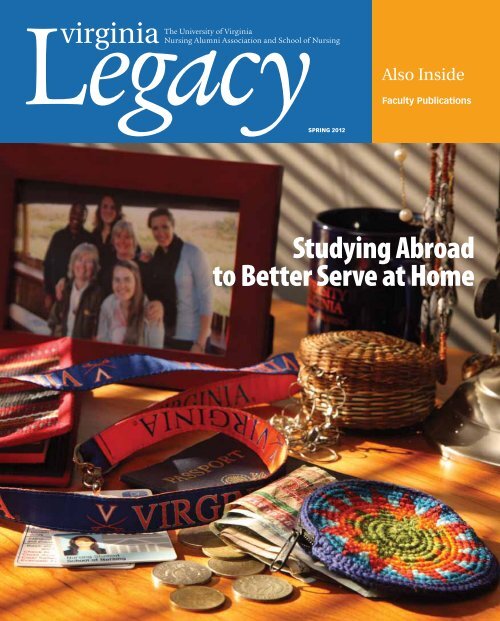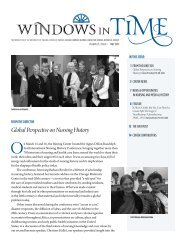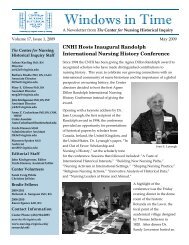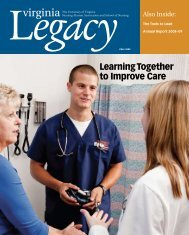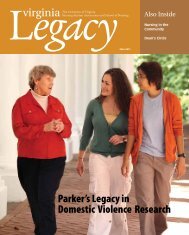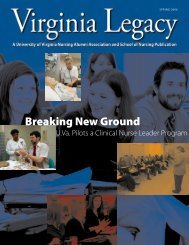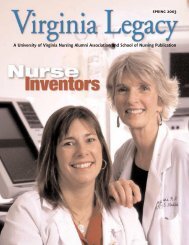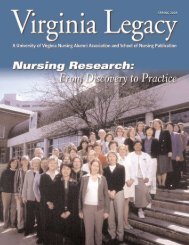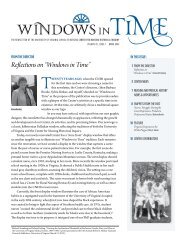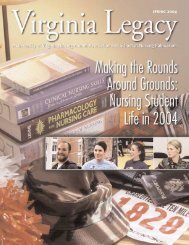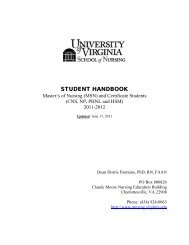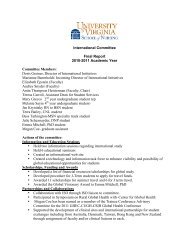Studying Abroad to Better Serve at Home - School of Nursing ...
Studying Abroad to Better Serve at Home - School of Nursing ...
Studying Abroad to Better Serve at Home - School of Nursing ...
- No tags were found...
You also want an ePaper? Increase the reach of your titles
YUMPU automatically turns print PDFs into web optimized ePapers that Google loves.
Reaching Out … with RespectBenefits <strong>of</strong> Study and Research <strong>Abroad</strong>Dean Dorrie FontaineHow Does studying and learning in other countries help us <strong>to</strong> become better nurses here<strong>at</strong> home? This issue <strong>of</strong> Virginia Legacy answers th<strong>at</strong> question. I invite you <strong>to</strong> review the evidence inthese s<strong>to</strong>ries <strong>of</strong> our students and faculty who have chosen <strong>to</strong> reach out, stretch themselves, and learnfrom—and among—other cultures. Some <strong>of</strong> the insights they reveal include the following:• Study abroad cre<strong>at</strong>es resilient, cre<strong>at</strong>ive, and emp<strong>at</strong>hic nursing leaders;• Being fully present with persons from other cultures in their own communities informs thediscipline <strong>of</strong> nursing and engages our UVA nursing students and faculty in discovering a deepermeaning <strong>of</strong> nursing through care for p<strong>at</strong>ients around the world;• Lessons from abroad can improve the care we provide in Charlottesville and beyond; and• Men<strong>to</strong>ring others and making a difference occurs only within a framework <strong>of</strong> deep respect forall involved.Cre<strong>at</strong>ing leaderswho can navig<strong>at</strong>ein the world andpropose solutions<strong>at</strong> the p<strong>at</strong>ient,community,organiz<strong>at</strong>ion, andglobal levels is par<strong>to</strong>f our mission <strong>of</strong>excellence for theUVA <strong>School</strong> <strong>of</strong><strong>Nursing</strong>.Cre<strong>at</strong>ing Respectful LeadersCre<strong>at</strong>ing leaders who can navig<strong>at</strong>e in the world and propose solutions <strong>at</strong> the p<strong>at</strong>ient, community,organiz<strong>at</strong>ion, and global levels is part <strong>of</strong> our mission <strong>of</strong> excellence for the UVA <strong>School</strong> <strong>of</strong> <strong>Nursing</strong>. Incollabor<strong>at</strong>ing with other UVA schools and schools <strong>of</strong> nursing around the world, Marianne Baernholdt,assistant pr<strong>of</strong>essor and direc<strong>to</strong>r for intern<strong>at</strong>ional initi<strong>at</strong>ives, ensures in-depth learning opportunitiesfor students and faculty in all our global endeavors. Further, she makes certain th<strong>at</strong> they also have amarked impact on our own community.In the 2010 leadership text, The Growth and Development <strong>of</strong> Nurse Leaders, Angela BarronMcBride, dean emeritus from Indiana University <strong>School</strong> <strong>of</strong> <strong>Nursing</strong>, suggests th<strong>at</strong> a powerful way<strong>to</strong> develop nursing leaders is <strong>to</strong> tell those with potential th<strong>at</strong> they are leaders. For Mr. Jefferson’sUVA student nurses <strong>of</strong> <strong>to</strong>day, th<strong>at</strong> is not difficult <strong>to</strong> do. Our students are engaged in demonstr<strong>at</strong>ingleadership early and <strong>of</strong>ten. Whether they use their talents in an individualized study-abroad program orhere <strong>at</strong> home, their ability <strong>to</strong> inspire others is remarkable. According <strong>to</strong> McBride, lessons for growingnurse leaders include staying optimistic, reaching out <strong>to</strong> men<strong>to</strong>r others with a spirit <strong>of</strong> generosity, andalways listening as a key aspect <strong>of</strong> respect. Our faculty members emphasize all <strong>of</strong> these str<strong>at</strong>egies <strong>to</strong>cre<strong>at</strong>e respectful nursing leaders and nursing leaders who garner respect.Ensuring a Respectful Work Environment in a Caring CommunityI have just completed service with 25 staff and faculty from across the UVA Grounds on the RespectfulWorkplace Task Force (mentioned in the fall 2011 issue <strong>of</strong> Legacy) put in place by UVA PresidentTeresa Sullivan. We are committed <strong>to</strong> a healthy work environment in our <strong>School</strong> <strong>of</strong> <strong>Nursing</strong> as par<strong>to</strong>f an overall str<strong>at</strong>egic plan <strong>to</strong> cultiv<strong>at</strong>e an environment in which faculty and staff are respectedand students flourish. The yearlong work <strong>of</strong> our Task Force provides <strong>to</strong>ols <strong>to</strong> ensure our universalcommitment <strong>to</strong> respect for all as we cre<strong>at</strong>e a caring community with a mot<strong>to</strong> <strong>of</strong> ”A Caring CommunityStarts with Me.” For more inform<strong>at</strong>ion, see the new Respect@UVa website <strong>at</strong> www.hr.virginia.edu/go/respect. Thank you for supporting us and celebr<strong>at</strong>ing our success. As always, do let me know yourthoughts <strong>at</strong> dorrie.fontaine@virginia.edu.Dorrie FontaineSadie He<strong>at</strong>h Cabaniss Pr<strong>of</strong>essor <strong>of</strong> <strong>Nursing</strong> and Dean
NewsSpring 2012Edi<strong>to</strong>rLynn WoodsonManaging Edi<strong>to</strong>rKarol KozakEdi<strong>to</strong>rial AdvisersVic<strong>to</strong>ria Brunjes (BSN ’98), Reba MoyerChildress (BSN ’79, MSN ’91, FNP’92), Mary Eckenrode Gibson (BSN’75, MSN ’86), Randy Jones (BSN ’00,MSN ’02, PhD ’05), Lisa Kelley (BSN ’99),Gerald Mon<strong>to</strong>ya (MSN ’94, PCNP ’96,DNP ’98), Dorothy TullmannClass Notes & News Edi<strong>to</strong>rsElisangela BlevinsDesignRoseberriesContributing WritersJane Ford, K<strong>at</strong>hleen Valenzi Knaus,Karol Kozak, Charles Huffman,Grace Maselli; pro<strong>of</strong>ing by Gail HyderWiley; pho<strong>to</strong> editing by Anna EmeryPho<strong>to</strong>graphersDan Addison, Elizabeth Cantrell,Tom Cogill, Kevin Conley, Anna Emery,Jane Haley, Siri Haraldsted, Maria Heil,Coe SweetVirginia Legacy is published twotimes a year by the University <strong>of</strong>Virginia <strong>School</strong> <strong>of</strong> <strong>Nursing</strong> and<strong>Nursing</strong> Alumni Associ<strong>at</strong>ion.University <strong>of</strong> Virginia <strong>School</strong> <strong>of</strong> <strong>Nursing</strong>Alumni and Development OfficeP.O. Box 801015Charlottesville, VA 22908-1015(434) 924-0138(434) 982-3699 FAXe-mail: nursing-alumni@virginia.eduSadie He<strong>at</strong>h Cabaniss Pr<strong>of</strong>essor<strong>of</strong> <strong>Nursing</strong> and DeanDorrie Fontaine, RN, PhD, FAANUniversity <strong>of</strong> Virginia <strong>School</strong> <strong>of</strong> <strong>Nursing</strong>Established in 19012 Worth NotingRead the l<strong>at</strong>est news from the <strong>School</strong> <strong>of</strong> <strong>Nursing</strong>.15 From the <strong>Nursing</strong> Alumni Associ<strong>at</strong>ionFind upd<strong>at</strong>es on <strong>Nursing</strong> Alumni Associ<strong>at</strong>ion leadership, goals, and volunteeriniti<strong>at</strong>ives.Fe<strong>at</strong>ures6 <strong>Studying</strong> <strong>Abroad</strong> <strong>to</strong> <strong>Better</strong> <strong>Serve</strong> <strong>at</strong> <strong>Home</strong>UVA nursing students and faculty are making an impact around the world—and much <strong>of</strong> wh<strong>at</strong> they learn abroad makes them better <strong>at</strong> their jobs back inthe U.S. Learn how UVA’s intern<strong>at</strong>ional programs benefit students, faculty,and the nursing pr<strong>of</strong>ession.22 Selected Faculty Public<strong>at</strong>ionsFrom Alzheimer’s <strong>to</strong> wound care, UVA <strong>School</strong> <strong>of</strong> <strong>Nursing</strong> faculty researcherspublish a broad variety <strong>of</strong> studies and clinical insights th<strong>at</strong> may impact thefuture <strong>of</strong> health care. This year’s list <strong>of</strong> public<strong>at</strong>ions highlights our faculty’sscholarly achievements.In Every issue11 Philanthropy12 Impact: <strong>Nursing</strong> Research19 Class Notes and News20 Alumni in Action29 Virginia MomentsMain Switchboard: (434) 924-2743Admissions & Student ServicesToll-free: (888) 283-8703Visit us on the web <strong>at</strong>www.nursing.virginia.edu.Feedback Welcome!Please let us know wh<strong>at</strong> you think aboutthis issue <strong>of</strong> Virginia Legacy by writing <strong>to</strong>us <strong>at</strong> nursing-alumni@virginia.edu or theaddress above.Virginia Legacy is published usingpriv<strong>at</strong>e funds.Printed on 10% postconsumer recycled paperOn the cover: <strong>Nursing</strong> students bring back new skills andlife-changing memories from their intern<strong>at</strong>ional experiences.Pho<strong>to</strong> by Tom Cogill.At right: Fourth-year student Chibueze Nwaiwu uses hisnursing educ<strong>at</strong>ion in all aspects <strong>of</strong> his life.
“The opportunity <strong>to</strong> work with a long-time nursing men<strong>to</strong>r, DeanFontaine, <strong>at</strong> a legendary institution with high-quality academicprograms and strong leadership made saying ‘yes’ <strong>to</strong> UVA easy.”— Janie He<strong>at</strong>hJanie He<strong>at</strong>h sees expanding partnerships and preparing innov<strong>at</strong>ivenursing leaders as key <strong>to</strong> the <strong>School</strong>’s success.He<strong>at</strong>h Focuses onAcademic ProgrammingSince Oc<strong>to</strong>ber, Janie He<strong>at</strong>h, new associ<strong>at</strong>e dean for academicprograms, has been diving in<strong>to</strong> her role in UVA’s <strong>School</strong> <strong>of</strong><strong>Nursing</strong>. Her job is a big one: <strong>to</strong> work with nursing faculty andstaff <strong>to</strong> provide innov<strong>at</strong>ive and excellent educ<strong>at</strong>ional programsfor more than 700 undergradu<strong>at</strong>e and gradu<strong>at</strong>e students. Sheis more than ready for the challenge.“Some <strong>of</strong> my most exciting, and challenging, goals <strong>at</strong> UVAinclude expanding trans-disciplinary academic programs,cre<strong>at</strong>ing innov<strong>at</strong>ive partnerships, integr<strong>at</strong>ing research witheduc<strong>at</strong>ion and nursing practice, and preparing new leaders <strong>to</strong>address a transform<strong>at</strong>ion <strong>of</strong> health care and nursing educ<strong>at</strong>ion,”says He<strong>at</strong>h.He<strong>at</strong>h spent three decades in critical care nursing andacademia as a nurse practitioner, faculty member, andadministr<strong>at</strong>ive leader. She served as associ<strong>at</strong>e dean foracademic affairs and E. Louise Grant Pr<strong>of</strong>essor <strong>of</strong> <strong>Nursing</strong> <strong>at</strong>Georgia Health Sciences University (formerly Medical College <strong>of</strong>Georgia) College <strong>of</strong> <strong>Nursing</strong>. Her research on <strong>to</strong>bacco cess<strong>at</strong>ionand health promotion has received funding from HRSA, NIH,and found<strong>at</strong>ions th<strong>at</strong> support interpr<strong>of</strong>essional scholarly workand curricular innov<strong>at</strong>ions. He<strong>at</strong>h has taught in the University<strong>of</strong> South Carolina and George<strong>to</strong>wn University <strong>School</strong>s <strong>of</strong><strong>Nursing</strong>. She helped found the Nurses for Tobacco ControlCoalition and served on the American Heart Associ<strong>at</strong>ion’s Smokeless Tobacco Harm Reductionpanel in 2008.He<strong>at</strong>h received her associ<strong>at</strong>e and bachelor degrees in nursing from Cameron Universityin Oklahoma, her master’s from the University <strong>of</strong> Oklahoma, and a post-master’s adult nursepractitioner certific<strong>at</strong>e from the University <strong>of</strong> South Carolina. She earned her doc<strong>to</strong>r<strong>at</strong>e fromGeorge Mason University.When asked about her choice <strong>to</strong> come <strong>to</strong> UVA, He<strong>at</strong>h says, “The opportunity <strong>to</strong> work with along-time nursing men<strong>to</strong>r, Dean Fontaine, <strong>at</strong> a legendary institution with high-quality academicprograms and strong leadership made saying ‘yes’ <strong>to</strong> UVA easy.”2 Virginia Legacy Spring 2012
worth notingClinical Nurse LeaderProgram NearsFive‐Year MarkIn 2012, the first class <strong>of</strong> students <strong>to</strong>gradu<strong>at</strong>e from UVA’s Clinical NurseLeader (CNL) Program will mark their fifthreunion. In those five years, more than100 CNL students have earned degrees.Through the CNL program, UVA’s <strong>School</strong><strong>of</strong> <strong>Nursing</strong> prepares individuals withundergradu<strong>at</strong>e or gradu<strong>at</strong>e degrees inother disciplines <strong>to</strong> become registerednurses who lead <strong>at</strong> the point <strong>of</strong> care. In itsfirst five years, the program hasScholarship support will help P<strong>at</strong>ty Wilson pursue her dream <strong>of</strong>teaching nursing and helping survivors <strong>of</strong> intim<strong>at</strong>e partner violence.Wilson Wins N<strong>at</strong>ional AwardUniversity <strong>of</strong> Virginia nursing doc<strong>to</strong>ral student P<strong>at</strong>ty Wilson is dedic<strong>at</strong>ed <strong>to</strong> clinical work,research, and teaching focused on helping African American survivors <strong>of</strong> intim<strong>at</strong>e partnerviolence. Thanks <strong>to</strong> a Johnson & Johnson/American Associ<strong>at</strong>ion <strong>of</strong> Colleges <strong>of</strong> <strong>Nursing</strong> MinorityNurse Faculty Scholars Award—one <strong>of</strong> five given n<strong>at</strong>ionally—Wilson will be able <strong>to</strong> continueth<strong>at</strong> pursuit.The scholarships, awarded in associ<strong>at</strong>ion with Johnson & Johnson’s Campaign for <strong>Nursing</strong>’sfuture, help address the n<strong>at</strong>ion’s shortage <strong>of</strong> nurse educa<strong>to</strong>rs. The program provides $18,000 overthree years <strong>to</strong> gradu<strong>at</strong>e students from minority backgrounds who agree <strong>to</strong> teach in a nursingschool after gradu<strong>at</strong>ion.“<strong>Nursing</strong> schools across the country turned away 67,563 qualified applicants in 2010 due<strong>to</strong> a lack <strong>of</strong> doc<strong>to</strong>ral faculty,” says Dorrie Fontaine, dean <strong>of</strong> UVA <strong>School</strong> <strong>of</strong> <strong>Nursing</strong>. “Last year,Virginia produced only 19 doc<strong>to</strong>ral gradu<strong>at</strong>es. Ms. Wilson will help fill the significant need formore nurse-scientist faculty n<strong>at</strong>ionally and improve the diversity <strong>of</strong> our UVA faculty.”“<strong>Nursing</strong> is wh<strong>at</strong> I’ve always wanted <strong>to</strong> do,” says Wilson, who lives in Baltimore and commutes<strong>to</strong> Charlottesville for classes. As a clinical instruc<strong>to</strong>r in community/public health nursing <strong>at</strong>Johns Hopkins University and as assistant direc<strong>to</strong>r <strong>of</strong> the East Baltimore Community <strong>Nursing</strong>Centers—positions she still holds part-time—Wilson has witnessed firsthand the need for betterunderstanding <strong>of</strong> the complic<strong>at</strong>ed issues faced by survivors <strong>of</strong> intim<strong>at</strong>e partner violence, and theneed for research <strong>to</strong> develop policies. In her work with underserved popul<strong>at</strong>ions in the Hopkinscommunity outreach program, she sees many issues and barriers p<strong>at</strong>ients face, particularlyAfrican Americans.“P<strong>at</strong>ty is a real asset <strong>to</strong> our PhD program,” says K<strong>at</strong>hryn Laughon (BSN ’98, MSN ’99),UVA nursing pr<strong>of</strong>essor and expert on issues <strong>of</strong> intim<strong>at</strong>e partner violence. “In violence research,where we know th<strong>at</strong> African American women experience higher levels <strong>of</strong> violence and moresignificant health problems than other women, having African American researchers leadingthe research teams is critical.”n expanded <strong>to</strong> open admission <strong>to</strong>practicing registered nurses, withthe first cohort <strong>of</strong> RN-entry studentsscheduled <strong>to</strong> gradu<strong>at</strong>e this spring;n <strong>of</strong>fered 100 percent preceptedclinical learning activities for MSNentrystudents;n integr<strong>at</strong>ed leadership developmentthroughout the curriculum;n tackled critical reforms in nursingeduc<strong>at</strong>ion and emphasized nursingethics;n promoted global learning activities(half <strong>of</strong> each CNL class nowgoes outside <strong>of</strong> the U.S. for theircommunity clinical programs);n encouraged interpr<strong>of</strong>essionaleduc<strong>at</strong>ion opportunities andchartered the interdisciplinaryInstitute for Healthcare ImprovementOpen <strong>School</strong> (see rel<strong>at</strong>ed s<strong>to</strong>ry onpage 12); andn fostered interpr<strong>of</strong>essional researchwithin the UVA Medical Center.“The CNL program is providingnursing educ<strong>at</strong>ion th<strong>at</strong> is right for the21st century,” says Sharon Fickley(BSN ’94), a practicing nurse who iscurrently in the CNL program. The CNLClass <strong>of</strong> 2007 is invited <strong>to</strong> celebr<strong>at</strong>e their5th reunion on S<strong>at</strong>urday, June 2. For moreinform<strong>at</strong>ion, visit www.nursing.virginia.edu/alumni/events/reunions.www.nursing.virginia.edu Virginia Legacy 3
worth notingFaculty AchievementsBarbara J. Parker, Theresa A. Thomas Pr<strong>of</strong>essor <strong>of</strong> Primary Care <strong>Nursing</strong>,has been elected <strong>to</strong> co-chair the American Academy <strong>of</strong> <strong>Nursing</strong>’s expertpanel on violence for a two-year term. The Academy’s 1,800 fellowsare nursing’s most accomplished leaders in educ<strong>at</strong>ion, management,practice, and research.Sarah Farrell utilizes innov<strong>at</strong>ive technology <strong>to</strong>stimul<strong>at</strong>e learning.Farrell Named Exceptional<strong>Nursing</strong> Educa<strong>to</strong>rSarah Farrell (BSN ’81, MSN ’83), associ<strong>at</strong>epr<strong>of</strong>essor, has been named Elsevier’s2012 Exceptional <strong>Nursing</strong> Educa<strong>to</strong>r. This isthe publisher’s first annual nursing educa<strong>to</strong>raward, cre<strong>at</strong>ed <strong>to</strong> recognize the work <strong>of</strong> anoutstanding nursing faculty member whoshows exceptional skill, innov<strong>at</strong>ion, andeffectiveness in regard <strong>to</strong> promoting studentlearning, pr<strong>of</strong>essionalism, and self confidence.Farrell teaches inform<strong>at</strong>ics, healthpolicy, psychi<strong>at</strong>ric nursing, leadership, andan interpr<strong>of</strong>essional course on evalu<strong>at</strong>inghealth inform<strong>at</strong>ion on the Web. In the healthinform<strong>at</strong>ion course, she teaches students <strong>to</strong> besavvy consumers, critique content, and developtheir own web pages. According <strong>to</strong> the Elsevierpress release, “One <strong>of</strong> the compelling aspects<strong>of</strong> her nomin<strong>at</strong>ion involves the integr<strong>at</strong>ion <strong>of</strong>technology in<strong>to</strong> the classroom. She helps otherfaculty with new technologies and inspiresstudents and faculty <strong>to</strong> use technology intheir work.” Elsevier also recognizes Farrellfor involving students in research projectsusing emerging technologies for p<strong>at</strong>ients inhealth promotion and maintenance. As anexample, Elsevier points <strong>to</strong> a project th<strong>at</strong> usesan electronic screening <strong>to</strong>ol <strong>to</strong> help p<strong>at</strong>ientsaccess inform<strong>at</strong>ion about depression andalcohol use, especially in rural primary care.“To be recognized in this way shows theimportance <strong>of</strong> student learning outcomesduring a paradigm shift away from lectureand <strong>to</strong> more interactive learning using theright technologies,” say Farrell.Elsevier is one <strong>of</strong> the world’s leadingpublishers <strong>of</strong> health and scientific books andjournals and an innova<strong>to</strong>r in using technology<strong>to</strong> promote the discovery and applic<strong>at</strong>ion <strong>of</strong>scientific inform<strong>at</strong>ion.Linda Bullock, Jeanette Lancaster Alumni Pr<strong>of</strong>essor <strong>of</strong> <strong>Nursing</strong>,discusses her research focused on the impact <strong>of</strong> domestic violenceon newborns in a video recently produced by UVA. To w<strong>at</strong>ch the video,go <strong>to</strong>: campaign.virginia.edu/bullock.Sarah Farrell (BSN ’81, MSN ’83), associ<strong>at</strong>e pr<strong>of</strong>essor and practicing psychi<strong>at</strong>ric mentalhealth nurse clinician, researcher, and champion <strong>of</strong> technology, was invited <strong>to</strong> join theUVA Teaching Resource Center’s University Academy <strong>of</strong> Teaching as one <strong>of</strong> 37 inauguralmembers. The center brings <strong>to</strong>gether master teachers who have already helped othersreach a higher level <strong>of</strong> excellence and who are interested in <strong>of</strong>fering their expertise <strong>to</strong>colleagues across UVA Grounds.RN <strong>to</strong> BSN Students Attend Legisl<strong>at</strong>ive DayRN <strong>to</strong> BSN students, along with some UVA alumni, <strong>at</strong>tended the 2012 Legisl<strong>at</strong>ive Dayin Richmond. Each student followed a bill th<strong>at</strong> has been introduced <strong>to</strong> the Virginia GeneralAssembly. Many students met with p<strong>at</strong>rons <strong>of</strong> their bills <strong>to</strong> share their perspectives and <strong>to</strong>g<strong>at</strong>her research for course projects. The <strong>Nursing</strong> Alumni Associ<strong>at</strong>ion funded transport<strong>at</strong>ion<strong>to</strong> the event.4 Virginia Legacy Spring 2012
UVA’s Intern<strong>at</strong>ional <strong>Nursing</strong> Programs<strong>Studying</strong> <strong>Abroad</strong> <strong>to</strong> <strong>Better</strong>By K<strong>at</strong>hleen Valenzi KnausFrom 8 a.m. until noon last July, Blen Afework and Terra Bailey, gradu<strong>at</strong>estudents in the UVA <strong>School</strong> <strong>of</strong> <strong>Nursing</strong>’s Clinical Nurse Leader (CNL)Program, followed Dr. Nehassie Buche on her rounds through thepedi<strong>at</strong>ric clinic <strong>of</strong> the America World Adoption transition home in AddisAbaba, the capital city <strong>of</strong> Ethiopia.This particular transition home accommod<strong>at</strong>es 75 children, from newborn <strong>to</strong>age 13. While these children represent only a fraction <strong>of</strong> Ethiopia’s estim<strong>at</strong>ed 4.3 millionorphans, they are distinct for being among the most physically vulnerable. Children aresent <strong>to</strong> the transition home from other orphanages in Ethiopia because it maintains afully staffed clinic whose “physicians, nurses, and nannies have earned a reput<strong>at</strong>ion fortaking children on the verge <strong>of</strong> de<strong>at</strong>h and reviving them,” says Bailey.One such physician is Dr. Nehassie, a tireless pedi<strong>at</strong>rician who not only cares forthe direly sick orphans but also maintains a priv<strong>at</strong>e pedi<strong>at</strong>ric practice. Dr. Nehassieproved <strong>to</strong> be a passion<strong>at</strong>e teacher who provided the UVA students with hands-onexperience in making head-<strong>to</strong>-<strong>to</strong>e assessments <strong>of</strong> sick children. With her instructionand supervision, the students learned, among other things, how <strong>to</strong> diagnose and tre<strong>at</strong>scabies, how <strong>to</strong> recognize developmental delays, how <strong>to</strong> identify the loc<strong>at</strong>ion <strong>of</strong> upperrespira<strong>to</strong>ry infections, and how <strong>to</strong> quickly suction mucus out <strong>of</strong> airways.6 Virginia Legacy Spring 2012
From Gu<strong>at</strong>emala<strong>to</strong> Rural VirginiaFor C<strong>at</strong>herine (“C<strong>at</strong>”) Herring<strong>to</strong>n (CNL ’11),an intern<strong>at</strong>ional nursing experience in Gu<strong>at</strong>emalaled her back <strong>to</strong> Virginia as an RN health educa<strong>to</strong>r <strong>at</strong> theBlue Ridge Medical Center. The center serves migrantfarm workers, mostly from Mexico, living and working inNelson and Albemarle counties. Using a mobile unit,Herring<strong>to</strong>n—along with a family nurse practitioner andother key, Spanish-speaking staff—drives <strong>to</strong> areamigrant camps <strong>to</strong> administer health checks andtre<strong>at</strong>ments as part <strong>of</strong> the clinic on wheels.“It’s amazing how effective my UVA educ<strong>at</strong>ion has been,” Herring<strong>to</strong>nsays. “We were really taught how <strong>to</strong> advoc<strong>at</strong>e for our p<strong>at</strong>ients. I’m alsovery gr<strong>at</strong>eful for colleagues like Michael Sanchez, who was raised inNelson County and has the trust <strong>of</strong> the migrant farm workers.”Work in community health was always in the cards for Herring<strong>to</strong>n,whose career p<strong>at</strong>h <strong>to</strong>ok shape when she earned an undergradu<strong>at</strong>edegree <strong>at</strong> UVA in cultural anthropology. “It really influenced my directionand made me want <strong>to</strong> intervene in some way in public health within abroader cultural context,” she says. Herring<strong>to</strong>n went on <strong>to</strong> enter UVA’sClinical Nurse Leader program <strong>to</strong> realize her “dream <strong>of</strong> working hands-onwith people.”C<strong>at</strong> Herring<strong>to</strong>n, <strong>to</strong>gether with colleague Mike Sanchez, helps provide health educ<strong>at</strong>ion <strong>to</strong>migrant farm workers.When the opportunity presented itself <strong>to</strong> do a community health rot<strong>at</strong>ionas part <strong>of</strong> UVA’s Gu<strong>at</strong>emala Initi<strong>at</strong>ive, Herring<strong>to</strong>n enthusiastically dovein. “I chose Gu<strong>at</strong>emala because it required the longest time commitmentand Spanish language immersion,” she says <strong>of</strong> the more than six weeksspent last summer in Central America. It was an opportunity “th<strong>at</strong> providedall the <strong>to</strong>ols” for a meaningful experience, she explains. So much soth<strong>at</strong> she was invited back <strong>to</strong> particip<strong>at</strong>e in the Gu<strong>at</strong>emala Initi<strong>at</strong>ive as astudent men<strong>to</strong>r in the summer <strong>of</strong> 2011.“Global health nursing doesn’t have <strong>to</strong> happen in a far-<strong>of</strong>f land,” saysHerring<strong>to</strong>n. “Wh<strong>at</strong> takes place in the U.S. is just as central <strong>to</strong> helping p<strong>at</strong>ientsas wh<strong>at</strong> happens anywhere else. We are all working within thecontext <strong>of</strong> global health right here in Charlottesville.”crossing p<strong>at</strong>hs frequently with the <strong>School</strong>’s 40 current gradu<strong>at</strong>eand undergradu<strong>at</strong>e intern<strong>at</strong>ional or dual citizenship students.They are also surrounded by other students with priorintern<strong>at</strong>ional experience.The choice about where <strong>to</strong> go intern<strong>at</strong>ionally is highlyindividualized. While Afework liked the idea <strong>of</strong> returning <strong>to</strong>her n<strong>at</strong>ive Ethiopia <strong>to</strong> gain clinical experience, Julia Smith, afourth-year nursing student, was <strong>at</strong>tracted <strong>to</strong> the semester-longexchange <strong>at</strong> the University <strong>of</strong> Auckland, New Zealand, becauseshe loved the outdoors and wanted <strong>to</strong> experience the country’sincredible beauty.During her semester abroad, Smith particip<strong>at</strong>ed in amedical-surgical placement and a mental health placement.Unlike UVA, where she was accus<strong>to</strong>med <strong>to</strong> taking five classesper semester and doing clinicals twice a week, <strong>at</strong> the University<strong>of</strong> Auckland, her educ<strong>at</strong>ion was more concentr<strong>at</strong>ed andfocused. First, she spent four weeks studying theory rel<strong>at</strong>ed <strong>to</strong>“pr<strong>of</strong>essionalism in nursing” and five weeks in the cardiologyward maintaining the same schedule (8- and 12-hour shifts,including nights and weekends) as her nurse precep<strong>to</strong>r. Then shewas given a long break, during which she backpacked for 25 daysaround New Zealand’s South Island. She found inspir<strong>at</strong>ion inn<strong>at</strong>ure and in the positive <strong>at</strong>titudes <strong>of</strong> the people she met whoselives had been devast<strong>at</strong>ed as the result <strong>of</strong> the 6.3 magnitudeearthquake th<strong>at</strong> struck Christchurch in February 2011. Back inAuckland, she concluded the semester with two weeks <strong>of</strong> lectureson mental health theory, followed by four weeks <strong>of</strong> clinicals on anadolescent mental health ward. By the time she had finished, shehad clocked 340 hours <strong>of</strong> clinical experience—“a lot more than Iwould have gotten <strong>at</strong> home during the same timeframe,” she says.In the clinics, she learned much from her p<strong>at</strong>ients th<strong>at</strong> istransl<strong>at</strong>able <strong>to</strong> U.S. settings. “For example, I will be eager <strong>to</strong>incorpor<strong>at</strong>e cultural identity in<strong>to</strong> my future nursing care asI learned <strong>to</strong> do with the indigenous Maori p<strong>at</strong>ients I workedwith,” she says. “One <strong>of</strong> the most important aspects <strong>of</strong> care forMaori p<strong>at</strong>ients is incorpor<strong>at</strong>ing their family, which I found <strong>to</strong> bea very valuable part <strong>of</strong> recovery. Also, during my mental healthplacement, I learned the value <strong>of</strong> emp<strong>at</strong>hy and presence withservice users. You can assess a lot from simply playing a game<strong>of</strong> cards with a service user. I learned <strong>to</strong> have more <strong>of</strong> a recoverymindset, which I will continue <strong>to</strong> use with future p<strong>at</strong>ients.”Before leaving New Zealand, Smith <strong>to</strong>ok the University <strong>of</strong>Auckland’s exit exam, which she believes helped her preparefor entering the nursing pr<strong>of</strong>ession. “Overall, I gained a widerperspective on nursing worldwide, which has increased myenthusiasm for the pr<strong>of</strong>ession.”8 Virginia Legacy Spring 2012
Growing OpportunitiesWhile intern<strong>at</strong>ional opportunities have always beenavailable <strong>to</strong> <strong>School</strong> <strong>of</strong> <strong>Nursing</strong> faculty and students insome form, in 2006 the <strong>School</strong> formalized its intent <strong>to</strong> globalizethe curriculum. Doris Greiner, associ<strong>at</strong>e pr<strong>of</strong>essor, was named asthe first direc<strong>to</strong>r <strong>of</strong> intern<strong>at</strong>ional initi<strong>at</strong>ives. Greiner ably servedin th<strong>at</strong> role until her retirement in August 2011, when MarianneBaernholdt, assistant pr<strong>of</strong>essor, was appointed <strong>to</strong> the position.The direc<strong>to</strong>r <strong>of</strong> intern<strong>at</strong>ional initi<strong>at</strong>ives works closely withthe Intern<strong>at</strong>ional Committee, a standing committee <strong>of</strong> the UVA<strong>Nursing</strong> Faculty Organiz<strong>at</strong>ion th<strong>at</strong> includes student and facultyrepresent<strong>at</strong>ives from every program in the <strong>School</strong>. The direc<strong>to</strong>ralso represents the <strong>School</strong> in University-wide global initi<strong>at</strong>ives.Together, the direc<strong>to</strong>r and the Intern<strong>at</strong>ional Committee plan anddevelop curriculum, programs, and exchange opportunities inaccordance with the University <strong>of</strong> Virginia’s str<strong>at</strong>egic intern<strong>at</strong>ionalgoals. These programs and opportunities involve a growing lis<strong>to</strong>f countries, including Australia, the Bahamas, China, Denmark,Gre<strong>at</strong> Britain, Gu<strong>at</strong>emala, Honduras, Hong Kong, Lesotho, NewZealand, Singapore, South Africa, Sweden, Taiwan, and Thailand.Some <strong>of</strong> the programs are interdisciplinary, including the W<strong>at</strong>erand Health program in Limpopo and the Gu<strong>at</strong>emala Initi<strong>at</strong>ive.Today, the formal menu <strong>of</strong> intern<strong>at</strong>ional opportunities <strong>at</strong> the<strong>School</strong> <strong>of</strong> <strong>Nursing</strong> includes the following:n Student experiencesn Faculty collabor<strong>at</strong>ionsn Visiting scholarsn Intern<strong>at</strong>ional forums and programs about contemporaryglobal health issues, such as a recent program on nursingresearch on smoking cess<strong>at</strong>ion conducted in ChinaThis spring, the <strong>School</strong> is initi<strong>at</strong>ing its first faculty exchangewhen Elizabeth Epstein (BSN ’94, PhD ’07), assistant pr<strong>of</strong>essor,travels <strong>to</strong> Denmark <strong>to</strong> teach a course over spring break.Funding <strong>to</strong> support intern<strong>at</strong>ional study and research isavailable <strong>to</strong> students and faculty from internal and externalsources, including the <strong>School</strong> <strong>of</strong> <strong>Nursing</strong>, the Center for GlobalHealth, the Center for Undergradu<strong>at</strong>e Excellence, the JeffersonPublic Citizens academic public service program, the RavenSociety, the Center for Children, Families and the Law, theFulbright Program, and the G<strong>at</strong>es Found<strong>at</strong>ion, among others.“The reason we’re in such good shape is because <strong>of</strong> thehard work <strong>of</strong> Doris Greiner,” Baernholdt says <strong>of</strong> her predecessor.“We also have a fantastic Intern<strong>at</strong>ional Studies Office <strong>at</strong> UVA.My contribution as the new direc<strong>to</strong>r will be <strong>to</strong> push the nursingschool’s intern<strong>at</strong>ional initi<strong>at</strong>ives even more in the direction <strong>of</strong>research and interdisciplinary collabor<strong>at</strong>ions.”When asked <strong>to</strong> define the value <strong>of</strong> intern<strong>at</strong>ional educ<strong>at</strong>ion,Baernholdt, a n<strong>at</strong>ive <strong>of</strong> Denmark, speaks from first-handexperience: “By going <strong>to</strong> a clinic in a low-resource country, youlearn things th<strong>at</strong> can also be applied here, in rural southwestVirginia, for example,” she says. “You can bring something backth<strong>at</strong> is directly rel<strong>at</strong>ed <strong>to</strong> your nursing practice.”A Global Case StudyCNL students BlenAfework (l) andTerra Bailey sharean embrace withDr. Nehassie Buche,their instruc<strong>to</strong>r inEthiopia.Last summer, Baernholdt and faculty colleague C<strong>at</strong>hyCampbell, assistant pr<strong>of</strong>essor, collabor<strong>at</strong>ed on anintern<strong>at</strong>ional project <strong>at</strong> several clinics in MpumalangaProvince, a rural area <strong>of</strong> South Africa where access <strong>to</strong> healthcare, clean w<strong>at</strong>er, and transport<strong>at</strong>ion is limited. The pr<strong>of</strong>essorswere accompanied by two student research assistants—SarahBorchelt, a fourth-year nursing student, and Caitlin Carr, a 2011gradu<strong>at</strong>e <strong>of</strong> UVA’s Frank B<strong>at</strong>ten <strong>School</strong> <strong>of</strong> Leadership and PublicPolicy with ties <strong>to</strong> the UVA Center for Global Health. Borchelt andCarr assisted the pr<strong>of</strong>essors and conducted independent researchprojects on the palli<strong>at</strong>ive care (managing pain and symp<strong>to</strong>ms<strong>of</strong> serious illness) <strong>of</strong> children and on the policy implic<strong>at</strong>ions <strong>of</strong>delivering different models <strong>of</strong> HIV care in South Africa.The purpose <strong>of</strong> the trip, Baernholdt says, was <strong>to</strong> implementpalli<strong>at</strong>ive care partnerships in a region where the prevalence<strong>of</strong> HIV and AIDS cre<strong>at</strong>es the need for team-based care focusedon physical-symp<strong>to</strong>m management, quality <strong>of</strong> life, and theemotional and spiritual needs <strong>of</strong> p<strong>at</strong>ients and their families.Among their desired outcomes, the UVA team wanted <strong>to</strong>develop a learning-needs assessment <strong>of</strong> palli<strong>at</strong>ive care workers,the majority <strong>of</strong> whom are lay health care providers known ascommunity health workers. They also wanted <strong>to</strong> provide onsitetraining and evalu<strong>at</strong>e possible sites for placement <strong>of</strong> UVAstudents interested in global health.One <strong>of</strong> the clinics, the Acts Clinic, proved <strong>to</strong> be “the starmodel <strong>of</strong> how palli<strong>at</strong>ive care should be provided,” Baernholdtsays. Despite being loc<strong>at</strong>ed “in the middle <strong>of</strong> a rural area farfrom <strong>to</strong>wns,” the clinic provides a full continuum <strong>of</strong> care—frompedi<strong>at</strong>ric <strong>to</strong> geri<strong>at</strong>ric—<strong>to</strong> p<strong>at</strong>ients infected by HIV/AIDS and<strong>to</strong> the families and friends who care about them. The clinic’sinp<strong>at</strong>ient and outp<strong>at</strong>ient services are complemented by home-www.nursing.virginia.edu Virginia Legacy 9
UVA nursesconducted researchin rural South Africa,where access <strong>to</strong>health care is limited.based care for those unable <strong>to</strong> travel. Its outp<strong>at</strong>ient services aloneserve more than 3,000 p<strong>at</strong>ients a month.“The Acts Clinic’s outcomes were phenomenal,” saysBaernholdt. “I spoke <strong>to</strong> one obstetrician who had tre<strong>at</strong>ed 600women in a three-year period. During th<strong>at</strong> time, only one <strong>of</strong>those women delivered an HIV-positive baby. If pregnant womenwho are HIV positive receive tre<strong>at</strong>ment early enough, their babiesaren’t affected.”Campbell underscores the point. “We also learned a lot fromtheir model about how you get people <strong>to</strong> be compliant. For example,if someone misses an appointment, the clinic calls or visits them<strong>to</strong> make other arrangements for getting their medic<strong>at</strong>ions. Goingth<strong>at</strong> extra step is important <strong>to</strong> them, because they don’t want thedisease <strong>to</strong> spread in the community. All it takes is one missed dose. Itis th<strong>at</strong> kind <strong>of</strong> model <strong>of</strong> care we can bring back here.”In their interactions with the South African health careproviders, the UVA team noticed th<strong>at</strong> their hosts consistentlymaintained a big-picture public health view. “Not one place wevisited talked about ‘my p<strong>at</strong>ient’ or ‘my client,’” Baernholdt says.“They talked only about ‘the family’ or ‘the community.’ Thefocus was always on the group.”Transforming LivesAt the end <strong>of</strong> the day, even the more subtle aspects <strong>of</strong>intern<strong>at</strong>ional nursing have the power <strong>to</strong> be transform<strong>at</strong>ive.“Apartheid only ended in South Africa in 1994,” says Campbell.“For our partners there <strong>to</strong> see me, a black woman, and Marianne,a white Danish woman, working <strong>to</strong>gether—clearly as colleagues<strong>at</strong> the same pr<strong>of</strong>essional level—was eye-opening and inspiring.”For their part, the UVA team found inspir<strong>at</strong>ion in the way theSouth Africans marked the ending <strong>of</strong> their meetings with song.“It is hard <strong>to</strong> even describe the beauty <strong>of</strong> the wall <strong>of</strong> soundth<strong>at</strong> came <strong>at</strong> you,” says Campbell. “Their singing was our rewardfor a hard day <strong>of</strong> work. It was one <strong>of</strong> the strongest and most joyfulmoments <strong>of</strong> our visit.”Intern<strong>at</strong>ional Student ProgramsThe following opportunities are currently available for UVA nursing students who want <strong>to</strong> incorpor<strong>at</strong>e global experiences in<strong>to</strong> their educ<strong>at</strong>ion.Semester-long exchangesn Australia (University <strong>of</strong> Queensland)n Denmark (Metropolitan University Collegeand Danish Deaconess Found<strong>at</strong>ion’s <strong>Nursing</strong><strong>School</strong>)n New Zealand (University <strong>of</strong> Auckland)Short-term programsn Africa (Ethiopia, Lesotho, South Africa)n Bahamasn Europe (Denmark, Spain)n Indian L<strong>at</strong>in America (Colombia, Costa Rica,Honduras)n Marshall Islandsn Semester <strong>at</strong> Sea <strong>of</strong>ferings (Caribbean andMediterranean Seas)n January Term <strong>of</strong>ferings, UVA Intern<strong>at</strong>ionalStudies Officen Independent study, UVA Center for GlobalHealthOutside programsn Cyprus, Health Sciences, Global LearningSemestersn Danish Institute for Study <strong>Abroad</strong>, PublicHealth in Denmarkn Institute for the Intern<strong>at</strong>ional Educ<strong>at</strong>ion <strong>of</strong>Students, Santiago, Chile: Health StudiesWhen interests don’t m<strong>at</strong>ch existing opportunities,students may also initi<strong>at</strong>e experiences.The program inaugur<strong>at</strong>ed in summer 2010 <strong>at</strong>the America World Adoption transition homeclinic in Addis Ababa, Ethiopia, for example, wasestablished by Terra Bailey, who had worked forAmerica World Adoption while completing herprerequisites for the Clinical Nurse Leaders Program.When she discovered th<strong>at</strong> her CNL cohortincluded Blen Afework (CNL ’12), a woman whohad been born in Ethiopia and was fluent inAmharic, the country’s primary language, Baileywas inspired <strong>to</strong> cre<strong>at</strong>e a study-abroad opportunity<strong>at</strong> the adoption agency’s Ethiopian clinic.Working <strong>to</strong>gether, Bailey and Afework did thenecessary legwork <strong>to</strong> gain the support <strong>of</strong> UVAadministra<strong>to</strong>rs and represent<strong>at</strong>ives from theEthiopian transition home <strong>to</strong> cre<strong>at</strong>e a sustainablestudy-abroad program.For more inform<strong>at</strong>ion about the Intern<strong>at</strong>ionalProgram <strong>at</strong> the <strong>School</strong> <strong>of</strong> <strong>Nursing</strong>, visitwww.nursing.virginia.edu/global, or contact direc<strong>to</strong>rMarianne Baernholdt <strong>at</strong> (434) 924-2254or mb2vy@virginia.edu. To find out more aboutsupporting intern<strong>at</strong>ional initi<strong>at</strong>ives, contactAngie Dempsey <strong>at</strong> angiedempsey@virginia.eduor (434) 924-2627.10 Virginia Legacy Spring 2012
PhilanthropyBonnie ChisholmThe Chisholm-Diederichgift supports renov<strong>at</strong>ionsin progress <strong>at</strong> the <strong>School</strong><strong>of</strong> <strong>Nursing</strong>’s McLeodHall. The renov<strong>at</strong>ions willcre<strong>at</strong>e reconfigured spacesfor teaching and learningth<strong>at</strong> encourage gre<strong>at</strong>erstudent and facultycollabor<strong>at</strong>ion.Gift Celebr<strong>at</strong>es Life <strong>of</strong> Nurse PractitionerBonnie Chisholm (BSN ’75)recent gift <strong>to</strong> the <strong>School</strong> <strong>of</strong> <strong>Nursing</strong> commemor<strong>at</strong>es the inspiring life and work <strong>of</strong>A Bonnie Chisholm (BSN ’75). Bonnie is being memorialized by her family—her motherHilda Chisholm, her sister Janet Chisholm Spotswood, and Bonnie’s husband, Charles Diederich.In recognition <strong>of</strong> the family’s gift, a fifth-floor study nook in the renov<strong>at</strong>ed McLeod Hall will benamed in Bonnie’s honor.“We wanted <strong>to</strong> give back <strong>to</strong> the school th<strong>at</strong> initi<strong>at</strong>ed the nursing career Bonnie loved,”explains Janet Spotswood, who gradu<strong>at</strong>ed in 1977 from the UVA McIntire <strong>School</strong> <strong>of</strong> Commercewith a BS in accounting. “My sister fought heroically against breast cancer,” she adds. Bonnielost her b<strong>at</strong>tle with cancer in July 2010 <strong>at</strong> age 56.Bonnie was an “enthusiastic and extroverted” student <strong>of</strong> nursing and life, Janet explains. Adedic<strong>at</strong>ed nurse practitioner <strong>at</strong> the World Bank/IMF clinic in Washing<strong>to</strong>n, DC, Bonnie was alsoinstrumental in forming their breast cancer support group. According <strong>to</strong> the Chisholm family,Bonnie could address breast cancer p<strong>at</strong>ients’ fears and speak with personal experience and authorityabout chemotherapy, radi<strong>at</strong>ion, and surgery, having undergone each herself. Her courage, grace,and joy in living, even in the midst <strong>of</strong> the challenges <strong>of</strong> advanced breast cancer were inspir<strong>at</strong>ional.Bonnie’s nursing experiences contributed <strong>to</strong> her joy for life and her strength in adversity.After gradu<strong>at</strong>ing in 1975, Bonnie worked as a surgical intensive care nurse <strong>at</strong> UVA MedicalCenter. Bonnie earned an MSN from Vanderbilt University in 1978, and in 1989 Bonnie receivedher adult nurse practitioner certific<strong>at</strong>e from C<strong>at</strong>holic University <strong>of</strong> America. Among the additionalpositions Bonnie held throughout her varied career were cardiovascular clinical nurse specialistin the Veterans’ Administr<strong>at</strong>ion System and assistant pr<strong>of</strong>essor <strong>at</strong> Marshall University <strong>School</strong> <strong>of</strong><strong>Nursing</strong> in West Virginia.Bonnie also loved <strong>to</strong> scuba dive and dance. “My wife had a wonderful zest for life,” saysCharles Diederich, who was married <strong>to</strong> Bonnie for 18 years. Diederich also gradu<strong>at</strong>ed from UVA,earning a BA in English and economics in 1976. “The UVA nursing program deeply informedBonnie’s life,” Diederich adds.Becky Sparger (BSN ’75), a dear friend <strong>of</strong> Bonnie’s and a fellow nursing alumna, remembersBonnie’s life force and dynamism. “Bonnie had a very rich student life, taking on challenges,working fearlessly in the ICU as an undergradu<strong>at</strong>e, gradu<strong>at</strong>ing with honors and excelling in herfield,” Sparger says. “Every day I wear something <strong>of</strong> Bonnie’s as a reminder <strong>of</strong> her life, includingher UVA nursing school pin.”The Chisholm-Diederich gift, along with support from many other generous donors, hashelped the <strong>School</strong> <strong>of</strong> <strong>Nursing</strong> reach its goal for the McLeod Hall renov<strong>at</strong>ion campaign. (Sees<strong>to</strong>ry on page 5.) The renov<strong>at</strong>ions will cre<strong>at</strong>e reconfigured spaces for teaching and learning th<strong>at</strong>encourage gre<strong>at</strong>er student and faculty collabor<strong>at</strong>ion. The upd<strong>at</strong>ed space will fe<strong>at</strong>ure high-techeduc<strong>at</strong>ion spaces—including upd<strong>at</strong>ed, st<strong>at</strong>e-<strong>of</strong>-the-art simul<strong>at</strong>ion labs—as well as quiet spacesfor study or convers<strong>at</strong>ion.www.nursing.virginia.edu Virginia Legacy 11
<strong>Nursing</strong> research affects prevention measures, practice pro<strong>to</strong>cols, and policy—<strong>at</strong>the individual and institutional levels and throughout the n<strong>at</strong>ion’s health caresystem. University <strong>of</strong> Virginia nurses are leading the way in research th<strong>at</strong> has adirect impact on p<strong>at</strong>ient care <strong>to</strong>day and in the future.Impact<strong>Nursing</strong> Research Effecting Changesin Prevention, Practice, and Policy“Taking Care <strong>of</strong> Sugar”From fall 2009 <strong>to</strong> spring 2011, Sharon Utz,associ<strong>at</strong>e pr<strong>of</strong>essor, and Ishan Williams,assistant pr<strong>of</strong>essor, served as co-principalinvestiga<strong>to</strong>rs <strong>of</strong> an NIH-funded study called“Taking Care <strong>of</strong> Sugar.”The study, which also involved other researchersfrom UVA’s <strong>School</strong> <strong>of</strong> <strong>Nursing</strong> andHealth System, tested the effectiveness <strong>of</strong> s<strong>to</strong>rytellingas a means <strong>to</strong> teach African Americanshow <strong>to</strong> manage their diabetes. St<strong>at</strong>istically,African Americans with diabetes have muchhigher complic<strong>at</strong>ion r<strong>at</strong>es than other popul<strong>at</strong>ionswith diabetes.The researchers began by conductingfocus groups with African Americans livingin three rural counties in Virginia. Theparticipants were asked a series<strong>of</strong> open-ended questions abouttheir disease, and then asked<strong>to</strong> describe wh<strong>at</strong> an idealdiabetes self-managementprogram would look like.Rick Steeves (FNP’94), former pr<strong>of</strong>essor, washelping Utz conduct thefocus groups when he notedth<strong>at</strong> many participants <strong>of</strong>fereda “this is my s<strong>to</strong>ry”response instead <strong>of</strong>a factual outline.“Rick’s observ<strong>at</strong>ionsreallyhelped meframe the idea <strong>of</strong> using s<strong>to</strong>rytelling as a culturallymeaningful intervention for improvingdiabetes self-management in this popul<strong>at</strong>ion,”says Utz.Next, 32 African Americans with diabetesfrom Louisa County, VA, were recruited <strong>to</strong> particip<strong>at</strong>ein a s<strong>to</strong>rytelling-based intervention.Each week for eight weeks, participantsw<strong>at</strong>ched videotaped s<strong>to</strong>ries about people withdiabetes facing typical daily challenges, suchas planning meals in support <strong>of</strong> healthy bloodsugar levels. When the videos ended, a dieticianand a nurse guided the participants in aneduc<strong>at</strong>ional discussion about wh<strong>at</strong> they’d seenand wh<strong>at</strong> they might have done differently.“Over time, the participants becamemore open about discussing their ownsitu<strong>at</strong>ions and wh<strong>at</strong> they could do<strong>to</strong> help themselves,” Utz says.“We had hoped our interventionwould promote people’s ability <strong>to</strong>problem solve, and it did.”The participants—whosenumbers dropped <strong>to</strong> 25 by theend <strong>of</strong> the study—were followed fora year <strong>to</strong> see how well they managedtheir diabetes over time as aresult <strong>of</strong> the intervention.Sharon Utz helped pilota study <strong>to</strong> help AfricanAmericans bettermanage diabetes.Ishan Williams will continue <strong>to</strong> advance research indiabetes self management.The results were encouraging. By the end<strong>of</strong> the study,• average blood sugar levels had decreasedfrom 8.05 percent <strong>to</strong> 7.45 percent;• average blood pressure had dropped from138/82 <strong>to</strong> 127/78;• average body mass index had decreasedfrom 38.9 <strong>to</strong> 37.6;• knowledge about ways <strong>to</strong> self-managediabetes had increased from 61 percent<strong>to</strong> 76 percent;• daily actions <strong>to</strong> manage diabetes—suchas actions <strong>to</strong> protect one’s feet—had improved;and• 79 percent <strong>of</strong> participants were stillachieving the goals they had set for themselvesfor positive daily actions <strong>to</strong> managetheir diabetes.While the gains had actually been higher<strong>at</strong> the three-month mark than <strong>at</strong> the 12-monthmark, “the overall trend is th<strong>at</strong> they’re stillbetter than they were <strong>at</strong> the beginning,” Utz12 Virginia Legacy Spring 2012
From the <strong>Nursing</strong> AlumniAssoci<strong>at</strong>ionFrom the President“Embracing change,looking for opportunitiesfor growth, andremembering how<strong>at</strong>titude influencesbehavior propelus forward.”Spring in Charlottesville is always a wonderful time <strong>of</strong> year. Trees bud and flowers blossom,reminding me th<strong>at</strong> warmer we<strong>at</strong>her has arrived. The excitement <strong>of</strong> gradu<strong>at</strong>ion on theLawn provides an opportunity for students, faculty, parents, and alumni <strong>to</strong> g<strong>at</strong>her <strong>to</strong>getherand celebr<strong>at</strong>e this important miles<strong>to</strong>ne. While gradu<strong>at</strong>ion closes a chapter for many whohave come <strong>to</strong> live and study <strong>at</strong> the University, it also marks the beginning <strong>of</strong> a new adventure,perhaps in Charlottesville or in some distant country far away. Wherever your journey takesyou, you remain a vital part <strong>of</strong> our community.Change is inevitable. The Alumni Council says goodbye <strong>to</strong> outgoing members MaryGibson, Fran Vasaly, Carolyn DuVal, and Amanda Cunningham when their terms expirein June. Many thanks for your commitment and service <strong>to</strong> the <strong>School</strong> <strong>of</strong> <strong>Nursing</strong>Alumni Associ<strong>at</strong>ion. Four new members will be joining the Council in July(see following page), and we welcome them. Embracing change, lookingfor opportunities for growth, and remembering how <strong>at</strong>titude influencesbehavior propel us forward. I encourage you <strong>to</strong> make a difference bygetting involved. Please let us know how you are interested in servingour community by completing the volunteer form on our website:nursing.virginia.edu/alumni/volunteer/form or by sending me ane-mail <strong>at</strong> sharoncumbyfay@yahoo.com.Engaging and connecting with alumni is a priority for the <strong>School</strong><strong>of</strong> <strong>Nursing</strong> Alumni Associ<strong>at</strong>ion. The Alumni Council has started<strong>to</strong> explore how the alumni demographics will be changingduring the next several years. Understanding alumni interestsand how alumni want <strong>to</strong> give back <strong>to</strong> the <strong>School</strong> <strong>of</strong> <strong>Nursing</strong>remain key components <strong>of</strong> our research. Assessing ourintern<strong>at</strong>ional presence and the effect th<strong>at</strong> technology hason how we communic<strong>at</strong>e with alumni will be part <strong>of</strong> ourstudy. We welcome your input and particip<strong>at</strong>ion as we planfor the future.Thank you for the opportunity <strong>to</strong> serve as the presiden<strong>to</strong>f the <strong>School</strong> <strong>of</strong> <strong>Nursing</strong> Alumni Associ<strong>at</strong>ion. I am lookingforward <strong>to</strong> seeing many <strong>of</strong> you <strong>at</strong> Reunions 2012.Sharon Cumby Fay (BSN ’76, MSN ’80)Keswick, Virginiawww.nursing.virginia.edu Virginia Legacy 15
From the NaaDoing Good in VietnamIn February, 10 nursing alumni, staff, andfriends traveled <strong>to</strong> Vietnam as part <strong>of</strong> aprogram organized by the <strong>Nursing</strong> AlumniAssoci<strong>at</strong>ion and UVA Cavalier Travels.Participants provided much-needed basicmedical services <strong>to</strong> children <strong>at</strong> severalsites in Quang Tri Province, includingKhe-Sanh Elementary <strong>School</strong>.Pictured are Rebecca Treakle, C<strong>at</strong>herine Zuver,Thomas Sullivan, Linda Keyser, Jeni Hauver,Carrie Armstrong, Alise Martinez, Allie Tran, andSusan Goode.Council Welcomes Four New MembersFrom <strong>to</strong>p: Linda Halpin,Sandy Reed-Bryant,Rebecca Harmon, andAllie Tran.The Alumni Council has elected Linda Halpin (BSN ’75), Sandy Reed-Bryant (BSN ’78,MSN ’86), Rebecca Harmon (PhD ’03), and Allie Tran (BSN ’10) as its newest members.Their terms begin July 1.Halpin, <strong>of</strong> Annandale, VA, is a registered nurse <strong>at</strong> Inova Fairfax Hospital, with advancedpractice experience in adult cardiac surgery and outcome management and research. She holdsa master’s degree from George Mason University. For a number <strong>of</strong> years, Halpin has welcomednew UVA nursing gradu<strong>at</strong>es <strong>to</strong> Inova Health System and men<strong>to</strong>red student externs. She has alsoserved on the Alumni Council Scholarships Committee since 2007. This year, Halpin takes onthe role <strong>of</strong> scholarship coordina<strong>to</strong>r.Reed-Bryant, <strong>of</strong> Alexandria, VA, is the resident assessment coordina<strong>to</strong>r <strong>at</strong> Goodwin House, askilled nursing facility in Northern Virginia. In addition <strong>to</strong> her nursing degrees, Reed-Bryant completeda nurse executive fellowship <strong>at</strong> Whar<strong>to</strong>n <strong>School</strong> <strong>of</strong> Business. A member <strong>of</strong> the Council’s financecommittee since 2007, Reed-Bryant takes on the role <strong>of</strong> finance coordina<strong>to</strong>r for the upcoming term.Harmon, <strong>of</strong> Staun<strong>to</strong>n, VA, is an assistant pr<strong>of</strong>essor who teaches psychi<strong>at</strong>ric mental healthnursing <strong>to</strong> UVA gradu<strong>at</strong>e and undergradu<strong>at</strong>e nursing students. She has received alumni awards forinnov<strong>at</strong>ive teaching and faculty excellence. In 2011, she received the <strong>Nursing</strong> Alumni Associ<strong>at</strong>ionExcellence in Teaching Award. Harmon has authored or co-authored a number <strong>of</strong> public<strong>at</strong>ions,many on appreci<strong>at</strong>ive inquiry, an innov<strong>at</strong>ive method <strong>of</strong> str<strong>at</strong>egic planning. Harmon will serve asfaculty represent<strong>at</strong>ive <strong>to</strong> the Alumni Council and as vice president, communic<strong>at</strong>ions.Tran, <strong>of</strong> Res<strong>to</strong>n, VA, joins the Council as engagement coordina<strong>to</strong>r. An employee in theMedical ICU <strong>at</strong> UVA Medical Center, Tran also serves as an alumni class advoc<strong>at</strong>e, and, sincelast year, as a member <strong>of</strong> the Alumni Awards Committee. Tran is also a team member <strong>of</strong> UVA’sInterpr<strong>of</strong>essional Educ<strong>at</strong>ion Initi<strong>at</strong>ive, which develops new shared courses and activities fornursing and medical students.The Alumni Council also says goodbye <strong>to</strong> members who complete their terms thisyear: Fran Vasaly (BSN ’69), Carolyn DuVal (BSN ’69), Mary Gibson (BSN ’75, MSN ’86),Amanda Cunningham (BSN ’05), and P<strong>at</strong> Woodard (BSN ’69), who concludes her term aspresident emeritus in June.“We are gr<strong>at</strong>eful <strong>to</strong> our retiring members and <strong>to</strong> those new members coming on board,” saysSharon Fay (BSN ’76, MSN ’80), current Alumni Council president. “Their hard work, loyalty, andcommitment <strong>to</strong> the <strong>School</strong> helps <strong>to</strong> keep our UVA nursing community strong and connected.”16 Virginia Legacy Spring 2012
From the NaaAlumni Scholarship for<strong>Nursing</strong> GradsAny UVA nursing alumna/us returning foran additional nursing degree or certific<strong>at</strong>e<strong>at</strong> any institution is eligible <strong>to</strong> apply for the<strong>Nursing</strong> Alumni Associ<strong>at</strong>ion’s annual $3,000scholarship. Funding for this scholarship ismade possible by generous gifts from alumniand friends <strong>to</strong> the <strong>Nursing</strong> Annual Fund.Applic<strong>at</strong>ions for the 2012 scholarshipare due June 1. Find forms and guidelines <strong>at</strong>www.nursing.virginia.edu/alumni/resources/scholarships.Want <strong>to</strong> get more<strong>School</strong> <strong>of</strong> <strong>Nursing</strong>news? Make sure we have yourcorrect e-mail address. Send it <strong>to</strong>nursing-alumni@virginia.edu.Grier Medical AssistanceFund Offers Aid <strong>to</strong> AlumniThe Tabitha S. GrierMedical AssistanceFund provides valuablefinancial assistance <strong>to</strong>nursing alumni facingmedical expensesnot covered by insurance,Medicare, orMedicaid. Funding isdistributed annuallyby the <strong>Nursing</strong> AlumniAssoci<strong>at</strong>ion and may beused <strong>to</strong>ward personal medical expenses includingmedic<strong>at</strong>ions, physician or nursingcare, in-home or nursing home expenses,medical supplies, equipment, or hospitaliz<strong>at</strong>ion.Applic<strong>at</strong>ions are due August 1. Fulldetails and applic<strong>at</strong>ion forms are online <strong>at</strong>www.nursing.virginia.edu/alumni/grier.For more inform<strong>at</strong>ion, contact the Alumni& Development Office <strong>at</strong> (434) 924-0138 ornursing-alumni@virginia.edu.Thank you <strong>to</strong> all <strong>of</strong> our2012 ’Hoos Coming <strong>to</strong> Dinnerhosts! Thanks <strong>to</strong> you, alumnievents stretched fromCharlottesville <strong>to</strong> Sri Lanka.Look for more inform<strong>at</strong>ion onthe 2012 ’Hoos Coming <strong>to</strong>Dinner in the fall issue. Find outmore now <strong>at</strong> www.nursing.virginia.edu/alumni/events/dinner.<strong>Nursing</strong> studentsfrom the 1960s <strong>of</strong>teng<strong>at</strong>hered in the arcadenear the originalMcKim bench.Pho<strong>to</strong> courtesy <strong>of</strong> UVA’s Center for <strong>Nursing</strong> His<strong>to</strong>rical Inquiry.New McKim Bench Marks Fond MemoriesAt the November 2011 Advisory Board and Alumni Council meetings, the <strong>Nursing</strong> AlumniAssoci<strong>at</strong>ion unveiled a special gift <strong>to</strong> commemor<strong>at</strong>e the more than 1,500 nursing alumniwho lived in McKim Hall. <strong>Nursing</strong> alumni who lived in McKim Hall will remember a similarbench was placed in the arcade during their time <strong>at</strong> the <strong>School</strong>. The plaque reads as follows:In Honor <strong>of</strong>all the <strong>Nursing</strong> Students who lived and learnedin McKim Hall1931–1974Given by the UVA <strong>School</strong> <strong>of</strong> <strong>Nursing</strong> Alumni Associ<strong>at</strong>ionwww.nursing.virginia.edu Virginia Legacy 17
From the NaaReunions 2012<strong>School</strong> <strong>of</strong> <strong>Nursing</strong> EventsThomas JeffersonSociety ReunionsMay 14–16, 2012Celebr<strong>at</strong>ing the Class <strong>of</strong> 1962Wednesday, May 16<strong>School</strong> <strong>of</strong> <strong>Nursing</strong> Luncheon12:00 p.m.Join Dean Dorrie Fontaine and Sharon CumbyFay (BSN ’76, MSN ’80) <strong>at</strong> the induction <strong>of</strong>the Class <strong>of</strong> 1962 in<strong>to</strong> the Thomas JeffersonSociety. To learn more about other ThomasJefferson Society Reunion events or <strong>to</strong> registerfor the luncheon, please contact Alumni Hall<strong>at</strong> (434) 243-9000.AT BOTH REUNIONS<strong>School</strong> <strong>of</strong> <strong>Nursing</strong> Building ToursBoth reunion luncheons will be followed byoptional <strong>to</strong>urs <strong>of</strong> McKim Hall, McLeod Hall, andthe Claude Moore <strong>Nursing</strong> Educ<strong>at</strong>ion Building.McKim Hall, for many years the nursingresidence hall, is now part <strong>of</strong> the <strong>School</strong> <strong>of</strong>Medicine. McLeod Hall is undergoing renov<strong>at</strong>ion.You will be surprised by the upd<strong>at</strong>ed spaces!The Claude Moore <strong>Nursing</strong> Educ<strong>at</strong>ion Buildingopened in 2008.Undergradu<strong>at</strong>e Class ReunionsMay 31–June 3, 2012Celebr<strong>at</strong>ing the Classes <strong>of</strong> 1967, 1972, 1977, 1982, 1987, 1992, 1997, 2002, and 2007Friday, June 1Health Care Reform: Opportunities for Nursesand Physicians <strong>to</strong> Work Together in New Ways11:00 am—12:15 pm Minor Hall, Room 125Health care reform will <strong>of</strong>fer new opportunitiesfor all members <strong>of</strong> the health care workforce<strong>to</strong> better meet p<strong>at</strong>ient and family needs. DeanDorrie Fontaine and Dr. Jon<strong>at</strong>hon Truwit,UVA’s chief medical <strong>of</strong>ficer and senior associ<strong>at</strong>edean for clinical affairs, will discuss a model <strong>of</strong>health care for the future using the concepts<strong>of</strong> interpr<strong>of</strong>essional care and educ<strong>at</strong>ion asa framework. Using the skills and talents <strong>of</strong>the entire health care workforce <strong>to</strong> promoteimproved p<strong>at</strong>ient outcomes will be the focus,with positive examples highlighted from theUVA Health System. Following the seminar,Dean Fontaine will welcome guests in herhome, Pavilion IX, from 1:00–2:30 pm.S<strong>at</strong>urday, June 2<strong>School</strong> <strong>of</strong> <strong>Nursing</strong> Alumni LuncheonAll <strong>School</strong> <strong>of</strong> <strong>Nursing</strong> alumni are invited <strong>to</strong>g<strong>at</strong>her <strong>at</strong> McLeod Hall <strong>to</strong> visit classm<strong>at</strong>es,hear from Dean Dorrie Fontaine and SharonCumby Fay (BSN ’76, MSN ’80), <strong>Nursing</strong>Alumni Associ<strong>at</strong>ion president, and congr<strong>at</strong>ul<strong>at</strong>eAlumni Award winners.Alumni from the MSN-CNL Class <strong>of</strong> 2007are invited <strong>to</strong> celebr<strong>at</strong>e their 5th reunion. Allnursing alumni are welcome <strong>to</strong> <strong>at</strong>tend this event.A small fee will be charged <strong>to</strong> all <strong>at</strong>tendeesover the age <strong>of</strong> 12. Please register throughAlumni Hall <strong>at</strong> (434) 243-9000.Do you have pho<strong>to</strong>graphs, letters, or othermemorabilia from your time as a UVA nursingstudent or from the early days <strong>of</strong> your nursingcareer? Consider don<strong>at</strong>ing these items <strong>to</strong> the Centerfor <strong>Nursing</strong> His<strong>to</strong>rical Inquiry (CNHI) <strong>to</strong> add <strong>to</strong> yourReunion experience and <strong>to</strong> help preserve nursinghis<strong>to</strong>ry. Contact the CNHI staff <strong>at</strong> nursing-hxc@virginia.edu or (434) 924-0083.Visit www.virginiareunions.comfor registr<strong>at</strong>ion and complete weekend details on the UVA Alumni Associ<strong>at</strong>ion website.18 Virginia Legacy Spring 2012
Class Notes and News1950s1960s’56 DIPLO Julia Ellen Sadler <strong>of</strong> Arling<strong>to</strong>nHeights, IL, retired in November 2007 afterworking 25 years for four orthopedic surgeons.Her husband <strong>of</strong> 53 years, Hous<strong>to</strong>unMorgan Sadler, passed away in November <strong>of</strong>2011. The couple’s son, Hous<strong>to</strong>un McIn<strong>to</strong>shSadler, oversees trauma nurses in the ER<strong>at</strong> Rush-Presbyterian Hospital in Chicago.Their youngest daughter lives and worksin South Carolina. Their oldest daughterwent <strong>to</strong> the Sorbonne for her junior yearin college, and, after gradu<strong>at</strong>ion with a BSin Intern<strong>at</strong>ional Studies, she returned <strong>to</strong>Europe. There, she met her husband-<strong>to</strong>-bein his home<strong>to</strong>wn <strong>of</strong> Siena and was married25 years ago. They have two children, andthey all speak three languages.’65 DIPLO Connie Brennan, retired nursepractitionerand current member <strong>of</strong> NelsonCounty Board <strong>of</strong> Supervisors, ran for theVirginia House <strong>of</strong> Deleg<strong>at</strong>es, 59th Districtin 2011. She has served in elected <strong>of</strong>fice for14 years and is currently active in many organiz<strong>at</strong>ions,including the Sexual AssaultResource Agency, the Jefferson Area Board<strong>of</strong> Aging, the Sorensen Institute for PoliticalLeadership, and the Virginia Associ<strong>at</strong>ion<strong>of</strong> Counties Board, among others. She ismarried <strong>to</strong> John Hesselbart and has threechildren.’69 BSN K<strong>at</strong>hleen O’Brien Crispin <strong>of</strong>Greenville, SC, received the DistinguishedServant Award from the Bob Jones UniversityHonoring P<strong>at</strong> Cheeks and Her Fight <strong>to</strong> End Sexual ViolenceAlumna P<strong>at</strong> Cheeks (right) received the Sexual AssaultResource Agency’s annual award, named in honor <strong>of</strong>Annette Grimm (left).P<strong>at</strong> Cheeks (MSN ’83) has been dedic<strong>at</strong>ed <strong>to</strong> psychi<strong>at</strong>ric nursing for more than three decades.The daughter <strong>of</strong> a psychi<strong>at</strong>rist, Cheeks says, “At age 14 I knew wh<strong>at</strong> I wanted <strong>to</strong> do.”Since nursing school, Cheeks has had a hand in working with trauma survivors. “Ivolunteered <strong>at</strong> the Sexual Assault Resource Agency (SARA),” says Cheeks. In order for SARA<strong>to</strong> hold its monthly volunteer meetings, Cheeks was given a room <strong>to</strong> use <strong>at</strong> the Universityby Jeanne Fox, former UVA nursing school dean and pr<strong>of</strong>essor emeritus. “This happened <strong>at</strong>a time when trauma was only beginning <strong>to</strong> be researched. I was urged by my UVA nursingpr<strong>of</strong>essors <strong>to</strong> look critically <strong>at</strong> victimiz<strong>at</strong>ion, family, and community—<strong>to</strong> view it from aninterrel<strong>at</strong>ed ‘systems theory’ point <strong>of</strong> view,” notes Cheeks, who is now a board-certifiedpsychi<strong>at</strong>ric/mental health clinical nurse specialist in priv<strong>at</strong>e practice.Cheeks’ work with SARA evolved <strong>to</strong> include her role as board member. Last winter, forher outstanding contributions <strong>to</strong> end sexual violence, Cheeks was awarded SARA’s prestigiousannual Annette DeGregoria Grimm Award. According <strong>to</strong> Cheeks, “There’s no doubt th<strong>at</strong> myeduc<strong>at</strong>ion prepared me for this work.”www.nursing.virginia.edu Virginia Legacy 19
class notesAlumni Associ<strong>at</strong>ion in April 2011. K<strong>at</strong>hleenretired from Bob Jones University in May2011 after chairing the division <strong>of</strong> nursingfor 30 years.1990s’97 Jenny Sigel Burkett and her husband,Allen, <strong>of</strong> Chesapeake, VA, welcomed theirfirst child, Emma Faye, on July 5 2011.Both parents serve <strong>at</strong> Naval Medical CenterPortsmouth.’97 BSN, ’00 MSN Lorena Yoon Jung <strong>of</strong>Herndon, VA, completed her PhD studies <strong>at</strong>George Mason University <strong>School</strong> <strong>of</strong> <strong>Nursing</strong>in December 2010. During her master’s studies,Lorena worked with newly resettledrefugees from Bosnia and Kosovo in theCharlottesville area. During her PhD studies,Lorena conducted a quantit<strong>at</strong>ive study onpren<strong>at</strong>al Hispanic women’s trust in nurses,which earned her a best nursing research dissert<strong>at</strong>ionaward. Presently, Lorena is workingwith Dr. K<strong>at</strong>hy Richards as a post-doc<strong>to</strong>ralfellow in sleep research and in delaying mildcognitive impairment among the elderly.’98 BSN Angela Cushing Just <strong>of</strong> Falls Church,VA, works as a pedi<strong>at</strong>ric nurse practitioner<strong>at</strong> Inova Fairfax Hospital in the Pedi<strong>at</strong>ricEmergency Department. Her husband,Chris Just, is a James Madison Universitygradu<strong>at</strong>e. The couple has a two-year-olddaughter, Kelsey.2000s’05 BSN Elizabeth Bradshaw was named one<strong>of</strong> the first recipients <strong>of</strong> the Washing<strong>to</strong>nianExcellence in <strong>Nursing</strong> award in December.Elizabeth is a clinical coordina<strong>to</strong>r in cardiology<strong>at</strong> Children’s N<strong>at</strong>ional Medical Center inWashing<strong>to</strong>n, D.C.’05 BSN Jessica Farrell Von Bank <strong>of</strong> Res<strong>to</strong>n,VA, and husband Nic Von Bank, welcomedthe arrival <strong>of</strong> their second child, LydiaGrace, born on November 20, 2011. Jessica’sAlumni in ActionDiane McChesney Parfitt (BSN ’68)From Pedi<strong>at</strong>ric Nurse <strong>to</strong> Legisl<strong>at</strong>ive Activiste ran a real grassroots campaign and won!” says Diane“WMcChesney Parfitt (BSN ’68), a former RN and nurse educa<strong>to</strong>r<strong>of</strong> her appointment <strong>to</strong> the North Carolina House <strong>of</strong> Represent<strong>at</strong>ives.Parfitt was one <strong>of</strong> only two Democr<strong>at</strong>s elected out <strong>of</strong> 18 contested racesin 2010.In her political role, Parfitt leverages her nursing background <strong>to</strong>influence public policy. Her championing started with volunteerism inthe early 2000s when Parfitt, a married mother <strong>of</strong> two grown children,chaired the board <strong>of</strong> direc<strong>to</strong>rs <strong>of</strong> her local child advocacy center. Withcharacteristic determin<strong>at</strong>ion, Parfitt, who also holds a master’s degreein nursing from the University <strong>of</strong> North Carolina, Chapel Hill, helped<strong>to</strong> craft legisl<strong>at</strong>ion <strong>to</strong> protect victims <strong>of</strong> child abuse. “Child abuseprevention became my passion,” says the previous acute care pedi<strong>at</strong>ricnurse specialist who also taught nursing <strong>at</strong> UVA, Johns Hopkins, theUniversity <strong>of</strong> Utah, and the University <strong>of</strong> North Carolina <strong>at</strong> Chapel Hill.As a current member <strong>of</strong> the North Carolina Legisl<strong>at</strong>ive Health CareAppropri<strong>at</strong>ions Committee, Parfitt’s public policy interests also extend<strong>to</strong> “extreme” support <strong>of</strong> nursing educ<strong>at</strong>ion and political safeguards forMedicaid. “Especially during an economic downturn we are workinghard <strong>to</strong> preserve critical services and access <strong>to</strong> educ<strong>at</strong>ion,” she <strong>of</strong>fers.In particular, Parfitt has taken nurse practitioners—including ‘scope <strong>of</strong>practice’ issues for nurse midwives—under her protective wing. “I amintensely supportive <strong>of</strong> best practices,” Parfitt explains.A nursing background informs Diane Parfitt’s legisl<strong>at</strong>iveoutlook.Her longstanding instruction in nursing continues<strong>to</strong> play a pivotal role in Parfitt’s pr<strong>of</strong>essional life. “Mynursing background was the ideal asset <strong>to</strong> bring <strong>to</strong> mypolitical career,” adds Parfitt, a resident and book s<strong>to</strong>reowner in Fayetteville, NC, along with her husband,urologist Henry E. Parfitt, a 1970 UVA gradu<strong>at</strong>e.“Identifying problems, evalu<strong>at</strong>ing options, cre<strong>at</strong>ingcare plans and p<strong>at</strong>ient case studies—these all requirecollabor<strong>at</strong>ive steps taken by teams <strong>to</strong> optimize p<strong>at</strong>ientcare,” she says <strong>of</strong> her highly transferrable nursingeduc<strong>at</strong>ion. According <strong>to</strong> Parfitt, “The nursing processis a refreshing framework through which <strong>to</strong> viewgovernment legisl<strong>at</strong>ion with the goal <strong>of</strong> helping people.”20 Virginia Legacy Spring 2012
class notes’38 DIPLO Dorothy D. Puckett <strong>of</strong> SaintAugustine, FL, died on July 13, 2011.’49 BSNED Adele Bruce Kline <strong>of</strong>Lynchburg, VA, died on Oc<strong>to</strong>ber 20, 2011.’66 DIPLO Mildred K. Thorn<strong>to</strong>n <strong>of</strong>Swansboro, NC, died on July 30, 2011.’41 DIPLO Elvin Gochenour Bigham <strong>of</strong>Charlotte, NC, died on September 14, 2011.’50 DIPLO Frances Barlow Jefferies <strong>of</strong>Norfolk, VA, died on April 8, 2011.’71 BSN Brenda G. Bare <strong>of</strong>Fairfax St<strong>at</strong>ion, VA, died on June 4, 2011.’44 DIPLO Linda G. Davis <strong>of</strong> Alexandria, VA,died on January 11, 2012.’51 DIPLO Betty Jane Ely <strong>of</strong> Glasgow, KY,died on June 21, 2011.’79 BSN Kay Bays Ficzko <strong>of</strong> Charlotte, NC,died on Oc<strong>to</strong>ber 3, 2011.’46 DIPLO Gladys C. James <strong>of</strong> Danville, VA,died on December 19, 2011.’56 BSN K<strong>at</strong>hryn E. Brown <strong>of</strong>Williamsburg, VA, died on August 27, 2011.’81 BSN Janet Hunt Stepp <strong>of</strong> Glen Allen, VA,died on July 29, 2011.’46 DIPLO Nancy King Westerfield <strong>of</strong>Bris<strong>to</strong>l, TN, died on August 27, 2011.’56 DIPLO Yvonne Johnson <strong>of</strong>Charlottesville, VA, died on November 20, 2011.’92 FNP P<strong>at</strong>ricia B. D. Marshall <strong>of</strong>Madison, CT, died on February 1, 2012.’47 DIPLO Opal W. Henney <strong>of</strong>Palo Cedro, CA, died on November 20, 2011.’56 DIPLO Sue Bowles Neal <strong>of</strong> Norfolk, VA,died on Oc<strong>to</strong>ber 10, 2011.’98 BSN Anna Frances Wheelock <strong>of</strong>Gladys, VA, died September 19, 2011.’47 DIPLO Hazel Dickens Rowe <strong>of</strong>Johnson City, TN, died on June 12, 2011.’58 DIPLO Marilyn Angie Browne <strong>of</strong>Apex, NC, died on December 1, 2011.’03 PhD Gloria Lauderdale <strong>of</strong> Chelsea, AL,died on May 9, 2010.’48 DIPLO Virginia Fulcher Davenpor<strong>to</strong>f Charlottesville, VA, died onSeptember 5, 2011.’48 DIPLO Page Long Saunders <strong>of</strong>Overland Park, KS, died on January 20, 2012.’62 ND Betsy Hurt Carter <strong>of</strong> Appom<strong>at</strong><strong>to</strong>x, VA,died on September 28, 2010.’65 BSN Mary Ewers Kagey <strong>of</strong> Roanoke, VA,died on May 25, 2011.’03 BSN Kristi Ellen Pulcini <strong>of</strong>Earlysville, VA, died on September 18, 2011.mother, Sarah Farrell(BSN ’81, MSN ’82, andSON faculty) reportsth<strong>at</strong> Lydia’s big brother,Samuel, is also enjoyingthe new addition <strong>to</strong> thefamily.’07 BSN K<strong>at</strong>hleen McElroy King was marriedin September 2011 <strong>at</strong> the UVA Chapel.K<strong>at</strong>hleen and her husband, Mike, live inWashing<strong>to</strong>n, DC. K<strong>at</strong>hleen gradu<strong>at</strong>ed fromGeorge<strong>to</strong>wn University with a family nursepractitioner degree.’08 MSN Laura Anne Ven<strong>to</strong> <strong>of</strong> San Diego, CA,received the 2011 Nurse <strong>of</strong> the Year Award <strong>at</strong>University <strong>of</strong> California—San Diego HealthSystem for her work studying and implementinga new educ<strong>at</strong>ion str<strong>at</strong>egy <strong>to</strong> ensure th<strong>at</strong>p<strong>at</strong>ients understand how <strong>to</strong> care for themselveswhen they leave the hospital. In hermethod, nurses teach the p<strong>at</strong>ient and thenask the p<strong>at</strong>ient <strong>to</strong> repe<strong>at</strong> the instructions back<strong>to</strong> the nurse. Prior <strong>to</strong> UC San Diego, Lauraworked in East Timor, where malaria and tuberculosiswere rampant, and in South Africa,where HIV and AIDS thre<strong>at</strong>ened many people.’08 PhD Flo Mildred Weierbach <strong>of</strong>Jonesborough, TN, was selected as a ruralhealth fellow for 2012 by the American RuralHealth Associ<strong>at</strong>ion. Flo is an assistant pr<strong>of</strong>essor<strong>at</strong> East Tennessee St<strong>at</strong>e University.Your gift <strong>to</strong> the <strong>Nursing</strong>Annual Fund makes adifference!To make a gift, you may use the envelopeenclosed, or, <strong>to</strong> learn more about theimpact <strong>of</strong> your gift, scan the code belowwith your smart phone.You may also visit ourwebsite <strong>at</strong>nursing.virginia.edu.Thank you!www.nursing.virginia.edu Virginia Legacy 21
Selected 2011Faculty Public<strong>at</strong>ionsUVA nursing research directlyaffects the n<strong>at</strong>ion’s health carethrough improved clinicalpractice and prevention. It alsoimpacts n<strong>at</strong>ional issues in healthcare policy and helps UVA <strong>at</strong>trac<strong>to</strong>utstanding students and faculty.UVA researchers are prolific andwell regarded. This annual listing<strong>of</strong> selected faculty public<strong>at</strong>ionsrecognizes the breadth and depth<strong>of</strong> nursing research <strong>at</strong> UVA.ANDERSON, Joel, PhDAnderson, J. G., & Taylor, A. G. (2011). Bi<strong>of</strong>ieldtherapies in cardiovascular diseasemanagement: A brief review. Holistic <strong>Nursing</strong>Practice, 25(4), 199–204.Anderson, J. G., & Taylor, A. G. (2011). Effects <strong>of</strong>healing <strong>to</strong>uch in clinical practice: A system<strong>at</strong>icreview <strong>of</strong> randomized clinical trials. Journal <strong>of</strong>Holistic <strong>Nursing</strong>, 29(3), 221–228.Anderson, J. G., & Taylor, A. G. (2011). Themetabolic syndrome and mind-body therapies:A system<strong>at</strong>ic review <strong>of</strong> clinical trials. Journal<strong>of</strong> Nutrition and Metabolism, 2011, 1–8.doi:10.1155/2011/276419BAERNHOLDT, Marianne, PhD, MPH, RNBaernholdt, M., & Cottingham, S. (2011). TheClinical Nurse Leader—new nursing role withglobal implic<strong>at</strong>ions. Intern<strong>at</strong>ional <strong>Nursing</strong>Review, 58(1), 74–78.Baernholdt, M., Hin<strong>to</strong>n, I., Yan, G., Rose, K.,& Sheely, M. (2011). Fac<strong>to</strong>rs associ<strong>at</strong>edwith quality <strong>of</strong> life in older adults in theUnited St<strong>at</strong>es. Quality <strong>of</strong> Life Research, 20.doi:10.1007/s11136-011-9954-zBARBERO, Edie, PhD, RN, PMHNP-BCBarbero, E. (2011). The goose. Hospital Drive,6 [Online journal]. Retrieved from http://hospitaldrive.med.virginia.edu/hospital-drive/issue-6-summer-2011/the-goose/BOYER, Diane E., DNP, RN, PMHNP-BCCampbell, C., Boyer, D., Campbell, L., & Rovnyak,V. (2011). Pain management <strong>to</strong>pics <strong>of</strong> interestfor nurses in rural Appalachia. Journal <strong>of</strong>Continuing Educ<strong>at</strong>ion in <strong>Nursing</strong>, 42(12).BRASHERS, Valentina L., MD, FACP, FNAPBrashers, V. L. (2011). Alter<strong>at</strong>ions <strong>of</strong> cardiovascularfunction. In S. Huether & K. L. McCance(Eds.), Understanding p<strong>at</strong>hophysiology (5thed.). St. Louis, MO: Mosby.Brashers, V. L. (2011). Alter<strong>at</strong>ions <strong>of</strong> pulmonaryfunction. In S. Huether & K. L. McCance (Eds.),Understanding p<strong>at</strong>hophysiology (5th ed.). St.Louis, MO: Mosby.Brashers, V. L. (2011). Mechanisms <strong>of</strong> hormonalregul<strong>at</strong>ion. In S. Huether & K. L. McCance(Eds.), Understanding p<strong>at</strong>hophysiology (5thed.). St. Louis, MO: Mosby.Brashers, V. L. (2011). P<strong>at</strong>hophysiology online forUnderstanding p<strong>at</strong>hophysiology 5th edition, S.Huether & K. L. McCance (Eds.). St. Louis, MO:Elsevier.Brashers, V. L. (2011). Structure and function <strong>of</strong>the cardiovascular and lymph<strong>at</strong>ic systems.In S. Huether & K. L. McCance (Eds.),Understanding p<strong>at</strong>hophysiology (5th ed.). St.Louis, MO: Mosby.Brashers, V. L. (2011). Structure and function<strong>of</strong> the pulmonary system. In S. Huether& K. L. McCance (Eds.), Understandingp<strong>at</strong>hophysiology (5th ed.). St. Louis, MO:Mosby.Gott, K., & Brashers, V. L. (2011). Alter<strong>at</strong>ions <strong>of</strong>pulmonary function in children. In S. Huether& K. L. McCance (Eds.), Understandingp<strong>at</strong>hophysiology (5th ed.). St. Louis, MO:Mosby.McDaniel, N., & Brashers, V. L. (2011). Alter<strong>at</strong>ions<strong>of</strong> cardiovascular function in children.In S. Huether & K. L. McCance (Eds.),Understanding p<strong>at</strong>hophysiology (5th ed.). St.Louis, MO: Mosby.22 Virginia Legacy Spring 2012
Public<strong>at</strong>ionsCOX, K<strong>at</strong>hleen, PhD, RNCox, K. (2011). Evalu<strong>at</strong>ing the effectiveness<strong>of</strong> intercultural teachers. <strong>Nursing</strong>Educ<strong>at</strong>ion Perspectives, 32(2), 102–125.doi:10.5480/1536-5026-32.2.102DENNISON, Pamela, MSN, RN, CNLReid, K. B., & Dennison, P. (2011). The ClinicalNurse Leader (CNL®): Emergence <strong>of</strong> a poin<strong>to</strong>f-caresafety clinician. The Online Journal <strong>of</strong>Issues in <strong>Nursing</strong>, 16(3), 1–4.EASTHAM, Linda, PhD, RN, FNPEastham, L. (2011). Research using blogs ford<strong>at</strong>a: Public documents or priv<strong>at</strong>e musings?Research in <strong>Nursing</strong> & Health, 34(4), 353–361.doi:10.1002/nur.20443ERICKSON, Jeanne M., PhD, RN, AOCNErickson, J. M., Beck, S. L., Christian, B., Dudley,W., Hollen, P. J., Albrit<strong>to</strong>n, K., et al. (2011).F<strong>at</strong>igue, sleep-wake disturbances, and quality<strong>of</strong> life in adolescents receiving chemotherapy.Journal <strong>of</strong> Pedi<strong>at</strong>ric Hema<strong>to</strong>logy/Oncology,33(1), e17–e25.FARRELL, Sarah, PhD, RN, PMHCNS-BC, CNLKrauskopf, P. B., & Farrell, S. (2011). Accuracy andefficiency <strong>of</strong> novice nurse practitioners usingpersonal digital assistants. Journal <strong>of</strong> <strong>Nursing</strong>Scholarship, 43(2), 117–124. doi:10.1111/j.1547-5069.2011.01385.xMahone, I. H., Farrell, S. P., Hin<strong>to</strong>n, I., Moody,D., Rifkin, K., Moore, K., et al. (2011). Shareddecision making in mental health tre<strong>at</strong>ment:Qualit<strong>at</strong>ive findings from stakeholder focusgroups. Archives <strong>of</strong> Psychi<strong>at</strong>ric <strong>Nursing</strong>, 25(6),e27–e36. doi:10.1016/j.apnu.2011.04.003Mahone, I. H., Farrell, S. P., Hin<strong>to</strong>n, I., Johnson, R.,Moody, D., Rifkin, K., et al. (2011). Participa<strong>to</strong>ryaction research in public mental health and aschool <strong>of</strong> nursing: Qualit<strong>at</strong>ive findings from anacademic-community partnership. Journal <strong>of</strong>Participa<strong>to</strong>ry Medicine, 3, e10.FONTAINE, Dorrie K., RN, PhD, FAANFontaine, D. K., & Langs<strong>to</strong>n, N. F. (2011). Themaster’s is not broken: Commentary on “TheDoc<strong>to</strong>r <strong>of</strong> <strong>Nursing</strong> Practice: A n<strong>at</strong>ional workforceperspective.” <strong>Nursing</strong> Outlook, 59(3), 121–122.Ziehm, S. R., Uibel, I. C., Fontaine, D. K., &Scherzer, T. (2011). Success indica<strong>to</strong>rs foran acceler<strong>at</strong>ed masters entry nursingprogram: Staff RN performance. Journal<strong>of</strong> <strong>Nursing</strong> Educ<strong>at</strong>ion, 50(7), 395–403.doi:10.3928/01484834-20110429-02FRIBERG, Elizabeth, DNP, RNFriberg, E. (2011). Instruc<strong>to</strong>r’s guide. InM. Stanhope & J. Lancaster (Eds.), Publichealth nursing: Popul<strong>at</strong>ion-centered healthcare in the community, St. Louis, MO: Mosby.GIBSON, Mary E., PhD, RNConnolly, C., & Gibson, M. (2011). The “whiteplague” and color: Children, race, andtuberculosis in Virginia 1900–1935. Journal<strong>of</strong> Pedi<strong>at</strong>ric <strong>Nursing</strong>, 26(3), 230–238.doi:10.1016/j.pedn.2010.01.011GLICK, Doris F., PhD, RNWeierbach, F. M., Glick, D. F., & Lyder, C. H.(2011). Family and friends <strong>to</strong> the rescue:Experiences <strong>of</strong> rural older adults with heartfailure. Research in Geron<strong>to</strong>logical <strong>Nursing</strong>,4(4), 261–270. doi:10.3928/19404921-20110106-01GOEHLER, Lisa E., PhDGaykema, R. P. A., & Goehler, L. E. (2011).Ascending caudal medullary c<strong>at</strong>echolaminep<strong>at</strong>hways drive sickness-induced deficits inexplora<strong>to</strong>ry behavior: Brain substr<strong>at</strong>es forf<strong>at</strong>igue? Brain, Behavior, and Immunity, 25(3),443–460.Kubera, M., Obuchowicz, E., Goehler, L.,Brzeszcz, J., & Maes, M. (2011). In animalmodels, psychosocial stress-induced (neuro)inflamm<strong>at</strong>ion, apop<strong>to</strong>sis and reducedneurogenesis are associ<strong>at</strong>ed <strong>to</strong> theonset <strong>of</strong> depression. Progress in Neuro-Psychopharmacology & Biological Psychi<strong>at</strong>ry,35(3), 744–759.Maes, M., Kubera, M., Obuchowicz, E., Goehler,L., & Brzeszcz, J. (2011). Depression’s multiplecomorbidities explained by (neuro)inflamma<strong>to</strong>ryand oxid<strong>at</strong>ive & nitros<strong>at</strong>ive stress p<strong>at</strong>hways.Neuroendocrinology Letters, 32(1), 7–24.GRAY, Mikel, PhD, FNP-BC, PNP-BC, CUNP,CCCN, FAANP, FAANBeeckman, D., Woodward, S., & Gray, M. (2011).Incontinence-associ<strong>at</strong>ed derm<strong>at</strong>itis: Step-bystepprevention and tre<strong>at</strong>ment. British Journal<strong>of</strong> Community <strong>Nursing</strong>, 16(8), 382–389.Black, J. M., Gray, M., Bliss, D. Z., Kennedy-Evans,K. L., Logan, S., Baharestani, M. M., … & R<strong>at</strong>liff,C. R. (2011). MASD part 2: Incontinence-Mikel Gray publishes extensively on health issues rel<strong>at</strong>ed <strong>to</strong>urinary incontinence.associ<strong>at</strong>ed derm<strong>at</strong>itis and intertriginousderm<strong>at</strong>itis: A consensus. Journal <strong>of</strong> Wound,Os<strong>to</strong>my & Continence <strong>Nursing</strong>, 38(4), 359–370.Gray, M. (2011). Context for practice: Fillinggaps in our evidence base. Journal <strong>of</strong> Wound,Os<strong>to</strong>my & Continence <strong>Nursing</strong>, 38(6), 607–609.doi:10.1097/WON.0b013e318234beafGray, M. (2011). Context for practice: Footand nail care, moisture-associ<strong>at</strong>ed skindamage, telemedicine for wound care andbenchmarking pressure ulcer prevalence.Journal <strong>of</strong> Wound, Os<strong>to</strong>my & Continence<strong>Nursing</strong>, 38(3), 217–219. doi:10.1097/WON.0b013e3182181542Gray, M. (2011). Context for practice:Intertriginous derm<strong>at</strong>itis, NPWT for pilonidaldisease, calciphylaxis, and more. Journal <strong>of</strong>Wound, Os<strong>to</strong>my & Continence <strong>Nursing</strong>, 38(4),335–337. doi:10.1097/WON.0b013e31822275e0Gray, M. (2011). Context for practice: Anew year. Journal <strong>of</strong> Wound, Os<strong>to</strong>my &Continence <strong>Nursing</strong>, 38(1), 11–13. doi:10.1097/WON.0b013e318203ea25Gray, M. (2011). Context for WOC practice:Continence section edi<strong>to</strong>r transition. Journal <strong>of</strong>Wound, Os<strong>to</strong>my & Continence <strong>Nursing</strong>, 38(2),117–119. doi:10.1097/WON.0b013e31820c60ffGray, M. (2011). Traces: Making sense<strong>of</strong> urodynamics testing—part 3:Electromyography <strong>of</strong> the pelvic floor muscles.Urologic <strong>Nursing</strong>, 31(1), 31–38.24 Virginia Legacy Spring 2012
Public<strong>at</strong>ionsGray, M. (2011). Traces: Making sense <strong>of</strong>urodynamics testing—part 4: Preparing thep<strong>at</strong>ient for multichannel urodynamics testing.Urologic <strong>Nursing</strong>, 31(2), 71–77.Gray, M. (2011). Traces: Making sense <strong>of</strong>urodynamics testing—part 5: Evalu<strong>at</strong>ion <strong>of</strong>bladder filling/s<strong>to</strong>rage functions. Urologic<strong>Nursing</strong>, 31(3), 149–153.Gray, M. (2011). Traces: Making sense <strong>of</strong>urodynamics testing—part 6: Evalu<strong>at</strong>ion<strong>of</strong> bladder filling/s<strong>to</strong>rage: Bladder wallcompliance and the detrusor leak pointpressure. Urologic <strong>Nursing</strong>, 31(4), 215–221, 235.Gray, M. (2011). Traces: Making sense <strong>of</strong> urodynamicstesting—part 7: Evalu<strong>at</strong>ion <strong>of</strong> bladder filling/s<strong>to</strong>rage: Evalu<strong>at</strong>ion <strong>of</strong> urethral sphincterincompetence and stress urinary incontinence.Urologic <strong>Nursing</strong>, 31(5), 267–277, 289.Gray, M. (2011). Traces: Making sense <strong>of</strong>urodynamics testing—part 8: Evalu<strong>at</strong>ingsens<strong>at</strong>ions <strong>of</strong> bladder filling. Urologic <strong>Nursing</strong>,31(6), 369–374.Gray, M., Black, J. M., Baharestani, M. M., Bliss,D. Z., Colwell, J. C., Goldberg, M., ... & R<strong>at</strong>liff,C. R. (2011). Moisture-associ<strong>at</strong>ed skin damage:Overview and p<strong>at</strong>hophysiology. Journal <strong>of</strong>Wound, Os<strong>to</strong>my & Continence <strong>Nursing</strong>, 38(3),233–241. doi:10.1097/WON.0b013e318215f798Gray, M. (2011). Transl<strong>at</strong>ional research and WOCnursing practice. Journal <strong>of</strong> Wound, Os<strong>to</strong>my& Continence <strong>Nursing</strong>, 38(5), 479–481.doi:10.1097/WON.0b013e31822bec42Hanno, P. M., Burks, D. A., Clemens, J. O.,Dmochowski, R. R., Erickson, D., Fitzgerald,M. P., … Gray, M., et al. (2011). AUA guidelinefor the diagnosis and tre<strong>at</strong>ment <strong>of</strong> interstitialcystitis/bladder pain syndrome. Journal <strong>of</strong>Urology, 185 (6), 2162–2170.Lukacz, E. S., Sampselle, C., Gray, M., Macdiarmid,S., Rosenberg, M., Ellsworth, P., et al. (2011).A healthy bladder: A consensus st<strong>at</strong>ement.Intern<strong>at</strong>ional Journal <strong>of</strong> Clinical Practice,65(10), 1026–1036. doi:10.1111/j.1742-1241.2011.02763.xvan Rijswijk, L., & Gray, M. (2011). Evidence,research, and clinical practice: A p<strong>at</strong>ientcenteredframework for progress in wound care.Os<strong>to</strong>my Wound Management, 57(9), 26–38.HARMON, Rebecca, PhD, RN, PMHCNS-BCMay, N., Becker, D., Frankel, R., Haizlip, J., Harmon,R., Plews-Ogan, M., et al. (2011). Appreci<strong>at</strong>iveinquiry in health care. New York: CrownPublishing.HEATH, Janie, PhD, APRN-BC, FAANMedeiros, R. S., NeSmith, E. G., He<strong>at</strong>h, J., Hawkins,M. L., Hawkins, D., & Bias, R. (2011). Midlevelhealth providers impact on ICU length <strong>of</strong> stay,p<strong>at</strong>ient s<strong>at</strong>isfaction, mortality, and resourceutiliz<strong>at</strong>ion. Journal <strong>of</strong> Trauma <strong>Nursing</strong>, 18(3),149–152. doi:10.1097/JTN.0b013e31822b7fafHINTON, Ivora, PhDBaernholdt, M., Hin<strong>to</strong>n, I., Yan, G., Rose, K.,& Sheely, M. (2011). Fac<strong>to</strong>rs associ<strong>at</strong>edwith quality <strong>of</strong> life in older adults in theUnited St<strong>at</strong>es. Quality <strong>of</strong> Life Research, 20.doi:10.1007/s11136-011-9954-zJones, R. A., Wenzel, J., Hin<strong>to</strong>n, I., Cary, M., Jones,N. R., Krumm, S. et al. (2011). Exploring cancersupport needs for older African Americanmen with prost<strong>at</strong>e cancer. Supportive Care inCancer, 19(9), 1411–1419.Mahone, I. H., Farrell, S. P., Hin<strong>to</strong>n, I., Johnson, R.,Moody, D., Rifkin, K., <strong>at</strong> al. (2011). Participa<strong>to</strong>ryaction research in public mental health and aschool <strong>of</strong> nursing: Qualit<strong>at</strong>ive findings from anacademic-community partnership. Journal <strong>of</strong>Participa<strong>to</strong>ry Medicine, 3, e10.Mahone, I. H., Farrell, S. P., Hin<strong>to</strong>n, I., Moody,D., Rifkin, K., Moore, K., et al. (2011). Shareddecision making in mental health tre<strong>at</strong>ment:Qualit<strong>at</strong>ive findings from stakeholder focusgroups. Archives <strong>of</strong> Psychi<strong>at</strong>ric <strong>Nursing</strong>, 25(6),e27–e36. doi:10.1016/j.apnu.2011.04.003Williams, I. C., Utz, S. W., Jones, R., Hin<strong>to</strong>n,I., Steeves, R., & Alexander, G. (2011).Recruitment <strong>of</strong> rural African Americans forresearch projects: Lessons learned. SouthernOnline Journal <strong>of</strong> <strong>Nursing</strong> Research, 11(1).Retrieved from http://www.resourcenter.net/images/SNRS/Files/SOJNR_articles2/Vol11Num01Art08.htmlHOLLEN, P<strong>at</strong>ricia, PhD, RN, FAANO’Laughlen, M., Rance, K., Rovnyak, V., & Hollen, P.(2011). Adherence r<strong>at</strong>es by Nurse Practitioners<strong>to</strong> the N<strong>at</strong>ional Asthma Educ<strong>at</strong>ional PreventionProgram (NAEPP) guidelines [Abstract]. Journal<strong>of</strong> Allergy and Clinical Immunology, 127(2), AB46.JONES, Randy, PhD, RNJones, R. A., Wenzel, J., Hin<strong>to</strong>n, I., Cary, M., Jones,N. R., Krumm, S. et al. (2011). Exploring cancersupport needs for older African Americanmen with prost<strong>at</strong>e cancer. Supportive Care inCancer, 19(9), 1411–1419.Williams, I. C., Utz, S. W., Jones, R., Hin<strong>to</strong>n,I., Steeves, R., & Alexander, G. (2011).Recruitment <strong>of</strong> rural African Americans forresearch projects: Lessons learned. SouthernOnline Journal <strong>of</strong> <strong>Nursing</strong> Research, 11(1).Retrieved from http://www.resourcenter.net/images/SNRS/Files/SOJNR_articles2/Vol11Num01Art08.htmlKANE, C<strong>at</strong>herine F., PhD, RN, FAANTierney, K. R., & Kane, C. (2011). Promotingwellness and recovery for persons withserious mental illness: A program evalu<strong>at</strong>ion.Archives <strong>of</strong> Psychi<strong>at</strong>ric <strong>Nursing</strong>, 25(2), 77–89.KEELING, Arlene W., PhD, RN, FAANKeeling, A. (2011). Clinics in the “suitcasecamps”: <strong>Nursing</strong> the migrants during the Gre<strong>at</strong>Depression, 1938–1941. Windows in Time,19(1), 8–11.Thompson, M. E., & Keeling, A. (2011). Nurses’role in the prevention <strong>of</strong> infant mortality in1884–1925: Health disparities then and now.Journal <strong>of</strong> Pedi<strong>at</strong>ric <strong>Nursing</strong>, 26. doi:10.1016/j.pedn.2011.05.011KULBOK, Pamela A., DNSc, RN, PHCNS-BC,FAANKulbok, P. A., & Botchwey, N. D. (2011). Promotinghealthy communities using multilevelparticipa<strong>to</strong>ry str<strong>at</strong>egies. In M. Stanhope &J. Lancaster (Eds.), Public health nursing (8thed.), St. Louis, MO: Mosby.Noonan, D., Kulbok, P., & Yan, G. (2011). Intention<strong>to</strong> smoke <strong>to</strong>bacco using a w<strong>at</strong>erpipe amongstudents in a southeastern U.S. college. Publichealth nursing, 28(6), 494–502. doi:10.1111/j.1525-1446.2011.00945.xLANCASTER, B. Jeanette, PhD, RN, FAANStanhope, M. K., & Lancaster, B. J. (2011). Publichealth nursing (8th ed.), St. Louis, MO: Mosby.LAUGHON, K<strong>at</strong>hryn C., PhD, RN, FAANBloom, T., Bullock, L., Sharps, P., Laughon, K., &Parker, B. (2011). Intim<strong>at</strong>e partner violence duringpregnancy. In J. Humphreys & J. Campbell(Eds.), Family Violence and <strong>Nursing</strong> Practice(2nd ed., pp. 155–180), New York: Springer.MAHONE, Irma H., PhD, RNMahone, I. H., Farrell, S. P., Hin<strong>to</strong>n, I., Moody,D., Rifkin, K., Moore, K., et al. (2011). Shareddecision making in mental health tre<strong>at</strong>ment:www.nursing.virginia.edu Virginia Legacy 25
Public<strong>at</strong>ionsQualit<strong>at</strong>ive findings from stakeholder focusgroups. Archives <strong>of</strong> Psychi<strong>at</strong>ric <strong>Nursing</strong>, 25(6),e27–e36. doi:10.1016/j.apnu.2011.04.003Mahone, I. H., Farrell, S. P., Hin<strong>to</strong>n, I., Johnson, R.,Moody, D., Rifkin, K., et al. (2011). Participa<strong>to</strong>ryaction research in public mental health and aschool <strong>of</strong> nursing: Qualit<strong>at</strong>ive findings from anacademic-community partnership. Journal <strong>of</strong>Participa<strong>to</strong>ry Medicine, 3, e10.O’LAUGHLEN, Mary, PhD, RN, FNP-BCO’Laughlen, M., Rance, K., Rovnyak, V., & Hollen, P.(2011). Adherence r<strong>at</strong>es by Nurse Practitioners<strong>to</strong> the N<strong>at</strong>ional Asthma Educ<strong>at</strong>ional PreventionProgram (NAEPP) guidelines [Abstract]. Journal<strong>of</strong> Allergy and Clinical Immunology, 127(2),AB46.Rance, K., & O’Laughlen, M. (2011). Obesity andasthma: A dangerous link in children. TheJournal for Nurse Practitioners, 7(4), 287–292.doi:10.1016/j.nurpra.2010.06.011Rance, K., O’Laughlen, M., & Ting, S. (2011).Improving asthma care for AfricanAmerican children by increasing asthmaguideline adherence. Journal <strong>of</strong> Pedi<strong>at</strong>ricHealth Care, 25(4), 235–249. doi:10.1016/j.pedhc.2010.04.010PARKER, Barbara J., PhD, RN, FAANBloom, T., Bullock, L., Sharps, P., Laughon, K., &Parker, B. (2011). Intim<strong>at</strong>e partner violenceduring pregnancy. In J. Humphreys & J. Campbell(Eds.), Family Violence and <strong>Nursing</strong> Practice(2nd ed., pp. 155–180), New York: Springer.Sawin, E, & Parker, B. (2011). “If looks wouldkill then I would be dead”: Intim<strong>at</strong>e partnerabuse and breast cancer in older women.Journal <strong>of</strong> Geron<strong>to</strong>logical <strong>Nursing</strong>, 37(7), 26–35.doi:10.3928/00989134-20110307-01QUATRARA, Beth, DNP, RN, CNSBallew, C., Buffmire, M. V., Fisher, C., Schmidt,P., Qu<strong>at</strong>rara, B., Conaway, M., & Burns, S. M.(2011). Fac<strong>to</strong>rs associ<strong>at</strong>ed with the level <strong>of</strong>backrest elev<strong>at</strong>ion in a thoracic cardiovascularintensive care unit. American Journal <strong>of</strong>Critical Care, 20(5), 395–399. doi:10.4037/ajcc2011884Elgin, K., Cozzi, K., Fowler, M., Perry, S., Davis, S.,Conaway, M., Qu<strong>at</strong>rara, B., & Burns, S. (2011).Maintaining p<strong>at</strong>ency with packed red bloodcell infusions: Comparison <strong>of</strong> IV normal salineinfusion vs. normal saline syringe method.Irma Mahone conducts far-reaching mental health research.MedSurg <strong>Nursing</strong>: The Journal <strong>of</strong> Adult Health,20(3), 134–138.Qu<strong>at</strong>rara, B. (2011). Acute pancre<strong>at</strong>itis & enteralfeeding: Wh<strong>at</strong> is the evidence? MedSurgM<strong>at</strong>ters, 20(1), 8–10.Qu<strong>at</strong>rara, B. (2011). Table <strong>of</strong> FDA-approvedpancre<strong>at</strong>ic enzyme replacement therapy.Practical Gastroenterology, 35(5), 19.RATLIFF, C<strong>at</strong>herine, PhD, APRN-BC, CWOCN,CFCNBlack, J. M., Gray, M., Bliss, D. Z., Kennedy-Evans,K. L., Logan, S., Baharestani, M. M., … & R<strong>at</strong>liff,C. R. (2011). MASD part 2: Incontinenceassoci<strong>at</strong>edderm<strong>at</strong>itis and intertriginousderm<strong>at</strong>itis: A consensus. Journal <strong>of</strong> Wound,Os<strong>to</strong>my & Continence <strong>Nursing</strong>, 38(4), 359–370.Colwell, J. C., R<strong>at</strong>liff, C. R., Goldberg, M., Baharestani,M. M., Bliss, D. Z., Gray, M., et al. (2011).MASD part 3: Peris<strong>to</strong>mal moisture-associ<strong>at</strong>edderm<strong>at</strong>itis and periwound moisture-associ<strong>at</strong>edderm<strong>at</strong>itis: A consensus. Journal <strong>of</strong> Wound,Os<strong>to</strong>my & Continence <strong>Nursing</strong>, 38(5), 541–553.Dixon, M., & R<strong>at</strong>liff, C. (2011). Hair braids asa risk fac<strong>to</strong>r for occipital pressure ulcerdevelopment: A case study. Os<strong>to</strong>my WoundManagement, 57(9), 48–53.Gray, M., Black, J. M., Baharestani, M. M.,Bliss, D. Z., Colwell, J. C., Goldberg, M., ... &R<strong>at</strong>liff, C. R. (2011). Moisture-associ<strong>at</strong>ed skindamage: Overview and p<strong>at</strong>hophysiology.Journal <strong>of</strong> Wound, Os<strong>to</strong>my & Continence<strong>Nursing</strong>, 38(3), 233–241. doi:10.1097/WON.0b013e318215f798R<strong>at</strong>liff, C. R. (2011). Are you a s<strong>to</strong>ma<strong>to</strong>logist andother os<strong>to</strong>my language conundrums. Os<strong>to</strong>myWound Management, 57(1), 1 p. preceding 14.R<strong>at</strong>liff, C. R. (2011). Lymphedema in acute andchronic wounds: Current managementconcepts. In R. Bryant & D. Nix (Eds.), Acuteand chronic wounds: Current managementconcepts (4th Ed.). St. Louis, MO: Mosby.REID, K<strong>at</strong>hryn, PhD, RN, CNL, FNP-BCReid, K. B., & Dennison, P. (2011). The ClinicalNurse Leader (CNL ® ): Emergence <strong>of</strong> a poin<strong>to</strong>f-caresafety clinician. The Online Journal <strong>of</strong>Issues in <strong>Nursing</strong>, 16(3), 1–4.ROSE, Karen M., PhD, RNBaernholdt, M., Hin<strong>to</strong>n, I., Yan, G., Rose, K.,& Sheely, M. (2011). Fac<strong>to</strong>rs associ<strong>at</strong>edwith quality <strong>of</strong> life in older adults in theUnited St<strong>at</strong>es. Quality <strong>of</strong> Life Research, 20.doi:10.1007/s11136-011-9954-zKim, H., & Rose, K. (2011). Sleep disturbances infamily caregivers: An overview <strong>of</strong> the st<strong>at</strong>e <strong>of</strong>the science. Archives <strong>of</strong> Psychi<strong>at</strong>ric <strong>Nursing</strong>,25(6), 456–468. doi:10.1016/j.apnu.2011.02.007Richards, K., Lambert, C., Beck, C., Bliwise, D.,Evans, W., Kalra, G., … Rose, K., et al. (2011).Strength training, walking, and social activityimprove sleep in nursing home and assistingliving residents: Randomized controlled trial.Journal <strong>of</strong> the American Geri<strong>at</strong>rics Society, 59(2),214–233. doi:10.1111/j.1532-5415.2010.03246.xRose, K., & Williams, I. C. (2011). Family m<strong>at</strong>ters:Family quality <strong>of</strong> life in dementia. Journal<strong>of</strong> Geron<strong>to</strong>logical <strong>Nursing</strong>, 37(6), 3–4.doi:10.3928/00989134-20110503-0626 Virginia Legacy Spring 2012
Public<strong>at</strong>ionsRose, K., Beck, C., Tsai, P., Liem, P., Davila, D.,Kleban, M., et al. (2011). Sleep disturbancesand nocturnal agit<strong>at</strong>ion behaviors in olderadults with dementia. Sleep, 34(6), 779–786.doi:10.5665/sleep.1048ROVNYAK, Virginia, PhDCampbell, C., Boyer, D., Campbell, L., & Rovnyak,V. (2011). Pain management <strong>to</strong>pics <strong>of</strong> interestfor nurses in rural Appalachia. Journal <strong>of</strong>Continuing Educ<strong>at</strong>ion in <strong>Nursing</strong>, 42(12).doi:10.3928/00220124-20111215-01O’Laughlen, M., Rance, K., Rovnyak, V., & Hollen, P.(2011). Adherence r<strong>at</strong>es by Nurse Practitioners<strong>to</strong> the N<strong>at</strong>ional Asthma Educ<strong>at</strong>ional PreventionProgram (NAEPP) guidelines [Abstract]. Journal<strong>of</strong> Allergy and Clinical Immunology, 127(2), AB46.Audrey Snyder’s research is informed by her intern<strong>at</strong>ionalnursing experiences.SNYDER, Audrey, PhD, RN, ACNP-BC, CEN,CCRN, FAANP, FAENMartin, M. L., & Snyder, A. E. (2011). Recentdevast<strong>at</strong>ing tragedies: Lessons learned. Race,culture, community. Journal <strong>of</strong> Race and Policy,7(1), 42–52.Martin, M. L., Snyder, A. E., & Saunders, M. E.(2011). Guest edi<strong>to</strong>rs’ prologue: UVA in St. Kittsand Nevis. Journal <strong>of</strong> Race and Policy, 7(1), 5–8.Snyder, A. E., Martin, M. L., et al. (2011). Theculture <strong>of</strong> St. Kitts and Nevis. Journal <strong>of</strong> Raceand Policy, 7(1), 9–14.Wright, E. B., Alibertis, K. J., & Snyder, A. E. (2011).Mass casualty incident health care providertraining drill: UVA in St. Kitts and Nevis. Journal<strong>of</strong> Race and Policy, 7(1), 115–123.SOUTHALL, Vickie H., MSN, RNSouthall, V. H. (2011). Rural health concepts. InJ. L. Creasia & E. Friberg (Eds.), Conceptualfound<strong>at</strong>ions: The bridge <strong>to</strong> pr<strong>of</strong>essionalnursing practice (5th ed., pp. 368–384), St.Louis, MO: Mosby.STEEVES, Richard H., PhD, RN, FAANWilliams, I. C., Utz, S. W., Jones, R., Hin<strong>to</strong>n,I., Steeves, R., & Alexander, G. (2011).Recruitment <strong>of</strong> rural African Americans forresearch projects: Lessons learned. SouthernOnline Journal <strong>of</strong> <strong>Nursing</strong> Research, 11(1).Retrieved from http://www.resourcenter.net/images/SNRS/Files/SOJNR_articles2/Vol11Num01Art08.htmlTAYLOR, Ann Gill, EdD, RN, FAANAnderson, J. G., & Taylor, A. G. (2011). Bi<strong>of</strong>ieldtherapies in cardiovascular diseasemanagement: A brief review. Holistic <strong>Nursing</strong>Practice, 25(4), 199–204.Anderson, J. G., & Taylor, A. G. (2011). Effects <strong>of</strong>healing <strong>to</strong>uch in clinical practice: A system<strong>at</strong>icreview <strong>of</strong> randomized clinical trials. Journal <strong>of</strong>Holistic <strong>Nursing</strong>, 29(3), 221–228.Anderson, J. G., & Taylor, A. G. (2011). Themetabolic syndrome and mind-body therapies:A system<strong>at</strong>ic review <strong>of</strong> clinical trials. Journal<strong>of</strong> Nutrition and Metabolism, 2011, 1–8.doi:10.1155/2011/276419Innes, K. E., Selfe, T. K., Alexander, G. K., &Taylor, A. G. (2011). A new educ<strong>at</strong>ional filmcontrol for use in studies <strong>of</strong> active mind-bodytherapies: Acceptability and feasibility. Journal<strong>of</strong> Altern<strong>at</strong>ive and Complementary Medicine,17(5), 453–458.Johnson, C. C., & Taylor, A. G. (2011). Researcherscombine evidence <strong>to</strong> foster study enrollment:Perspectives on putting in<strong>to</strong> practice wh<strong>at</strong>we know for studies involving Black women.Journal <strong>of</strong> Yoga and Physical Therapy, 1(1),e101. doi:10.4172/2157-7595.1000e101THOMPSON-HEISTERMAN, Anita, MSN, RN,PMHCNS-BC, PMHNP-BCThompson-Heisterman, A. A. (2011). Mentalhealth issues. In M. Stanhope & J. LancasterAnita Thompson-Heisterman focuses on complexmental health issues.(Eds.) Public Health <strong>Nursing</strong> (8th ed., pp. 784–803). St. Louis, MO: Mosby.UTZ, Sharon W., PhD, RNClark, M. L., & Utz, S. W. (2011). Use <strong>of</strong> diabetesself-management instruments among ruralAfrican American popul<strong>at</strong>ions. Southern OnlineJournal <strong>of</strong> <strong>Nursing</strong> Research, 11(1). Retrievedfrom R_articles2/Vol11Num01Art10.htmlWilliams, I. C., Utz, S. W., Jones, R., Hin<strong>to</strong>n,I., Steeves, R., & Alexander, G. (2011).Recruitment <strong>of</strong> rural African Americans forresearch projects: Lessons learned. SouthernOnline Journal <strong>of</strong> <strong>Nursing</strong> Research, 11(1).Retrieved from http://www.resourcenter.net/images/SNRS/Files/SOJNR_articles2/Vol11Num01Art08.htmlWILLIAMS, Ishan, PhDRose, K., & Williams, I. C. (2011). Family m<strong>at</strong>ters:Family quality <strong>of</strong> life in dementia. Journal<strong>of</strong> Geron<strong>to</strong>logical <strong>Nursing</strong>, 37(6), 3–4.doi:10.3928/00989134-20110503-06Williams, I. C., Utz, S. W., Jones, R., Hin<strong>to</strong>n,I., Steeves, R., & Alexander, G. (2011).Recruitment <strong>of</strong> rural African Americans forresearch projects: Lessons learned. SouthernOnline Journal <strong>of</strong> <strong>Nursing</strong> Research, 11(1).Retrieved from http://www.resourcenter.net/images/SNRS/Files/SOJNR_articles2/Vol11Num01Art08.htmlwww.nursing.virginia.edu Virginia Legacy 27
Faculty Members <strong>Serve</strong> as Expert Reviewers<strong>School</strong> <strong>of</strong> <strong>Nursing</strong> faculty are increasinglycalled <strong>to</strong> serve as expert reviewers <strong>of</strong> researchgrant proposals, such as those beingElizabeth Merwin credits serving on n<strong>at</strong>ional panels forhelping her spot new trends in nursing research.considered for funding by N<strong>at</strong>ional Institutes <strong>of</strong>Health (NIH) study sections and other federaland st<strong>at</strong>e agencies.One investiga<strong>to</strong>r <strong>to</strong> receive this pr<strong>of</strong>essionalhonor is Elizabeth Merwin, the MadgeM. Jones Pr<strong>of</strong>essor <strong>of</strong> <strong>Nursing</strong>, direc<strong>to</strong>r <strong>of</strong>the Rural Health Care Research Center, andassoci<strong>at</strong>e dean <strong>of</strong> research for the <strong>School</strong>.Merwin gained her initial experienceby reviewing research grantproposals for the American NursesFound<strong>at</strong>ion, the funding arm <strong>of</strong>the American Nurses Associ<strong>at</strong>ion.This year, she completes a five-yearmembership on the HealthcareSystems and Value Research StudySection, a standing committee <strong>of</strong>the Agency for Healthcare Researchand Quality (AHRQ).“To be involved with the AHRQin the midst <strong>of</strong> health care reformhas provided me with a lot <strong>of</strong> pr<strong>of</strong>essionalinsight about the kind <strong>of</strong>studies th<strong>at</strong> are needed <strong>to</strong> impactchanges,” Merwin says. “As a studysection member, I get <strong>to</strong> hear wh<strong>at</strong>’sgoing on <strong>at</strong> the agency—the issuesand priorities—from senior leaders as soon asthings can be talked about publicly. Th<strong>at</strong> hasbeen helpful in my role <strong>at</strong> the <strong>School</strong>.”Another investiga<strong>to</strong>r and expert revieweris Linda Bullock, the Jeanette Lancaster AlumniPr<strong>of</strong>essor <strong>of</strong> <strong>Nursing</strong> and direc<strong>to</strong>r <strong>of</strong> the <strong>School</strong>’sPhD Program. In 2010, Bullock concluded afour-year membership on the NIH <strong>Nursing</strong> andRel<strong>at</strong>ed Clinical Sciences Study Section. She hasalso particip<strong>at</strong>ed as an ad hoc member <strong>of</strong> theNINR/NRRC study section for F and K seriesgrants. By reading, critiquing, and arguing forand against specific research proposals, she hasgained important insights about wh<strong>at</strong> it takes<strong>to</strong> be competitive. She shares these insightswith PhD students taking her grant proposalwriting class, and she has used the knowledge <strong>to</strong>improve the effectiveness <strong>of</strong> her own proposals.“You’re really sitting <strong>at</strong> the table with the<strong>to</strong>p researchers in the United St<strong>at</strong>es—the crèmede la crème,” she says. These investiga<strong>to</strong>rsform a network <strong>of</strong> respected peers outside <strong>of</strong>the <strong>School</strong> th<strong>at</strong> Bullock can turn <strong>to</strong> when sheneeds <strong>to</strong> bounce around new ideas, or help the<strong>School</strong> recruit new faculty and seek placementsfor its gradu<strong>at</strong>ing students.Serving as a reviewer does have its downside.“It is a lot <strong>of</strong> work for no additional pay,”Bullock admits. “But I’m still glad I’ve doneit. There is no doubt th<strong>at</strong> it does a lot <strong>to</strong> helpthe <strong>School</strong>. It really does help you play on then<strong>at</strong>ional stage.”Faculty Serving on Research Study Sections (for prominent agencies within the last two years)Linda F. C. Bullock, PhD, RN, FAANStanding Member, NIH <strong>Nursing</strong> andRel<strong>at</strong>ed Clinical Sciences Study Section,2006–2010Ad hoc, NINR/NRRC study section for Fand K series grant, Oc<strong>to</strong>ber 2010Ad hoc, R43 reviewer for SBIR Phase I andII, STTR grant Phase I and II, 2012Pamela F. Cipriano, PhD, RN, NEA-BC,FAANAd hoc, Robert Wood JohnsonFound<strong>at</strong>ion, Future <strong>of</strong> <strong>Nursing</strong>, Campaignfor Action, 2011–presentSarah P. Farrell, PhD, RN, PMHCNS-BC,CNLAd hoc, Study section for HRSA FacultyDevelopment—Integr<strong>at</strong>ed Technology in<strong>to</strong><strong>Nursing</strong> Educ<strong>at</strong>ion grant program on HealthResources and Services Administr<strong>at</strong>ionAd hoc, Small Business Innov<strong>at</strong>ionResearch (SBIR), N<strong>at</strong>ional Institute <strong>of</strong>Mental Health, expert panelRandy Jones, PhD, RNAd hoc, Oncology <strong>Nursing</strong> SocietyFound<strong>at</strong>ion Small Research Grant StudySection, 2009–presentAd hoc, MS Society Research Grant, 2010.Ad hoc, Department <strong>of</strong> Defense, Prost<strong>at</strong>eCancer Research Program, 2010Pamela Kulbok, DNSc, RN, FAANAd hoc, Virginia Youth Tobacco ProjectSmall Grants Program ReviewerK<strong>at</strong>hryn Laughon, PhD, RNAmerican Nurses Found<strong>at</strong>ion/ SigmaTheta Tau Intern<strong>at</strong>ionalThe Centers for Disease Control andPrevention R49 Injury Control Researchand Demonstr<strong>at</strong>ion ProjectsAvon Found<strong>at</strong>ion N<strong>at</strong>ional mPowermentGrantsIrma Mahone, PhD, RN, MSNAd hoc, Society for Medical DecisionMaking, June, 2010Ad hoc, Virginia Daughters <strong>of</strong> theAmerican Revolution (DAR), Virginia <strong>Nursing</strong>Scholarship applic<strong>at</strong>ions (2008–2010)Ad hoc, American Psychi<strong>at</strong>ric <strong>Nursing</strong>Found<strong>at</strong>ion (APNF) Annual Research Grant2009, 2010Ad hoc, Sigma Theta Tau Intern<strong>at</strong>ional(STTI) Research Grant Opportunities2010–2011Elizabeth Merwin, PhD, RN, FAANStanding Member, Agency for HealthcareResearch and Quality Healthcare Systems &Value Research Study Section, 2007–2012Ad hoc, NIH N<strong>at</strong>ional Institute <strong>of</strong> <strong>Nursing</strong>Research, Various Awards, 2011Barbara Parker, PhD, RN, FAANReviewer: NIH Clinical Research LoanRepayment ProgramC<strong>at</strong>herine R<strong>at</strong>liff, PhD,APRN‐BC,CWOCN, CFCNOs<strong>to</strong>my Researcher, Board <strong>of</strong> Direc<strong>to</strong>rs,Center for Clinical Investig<strong>at</strong>ion <strong>of</strong> theWound, Os<strong>to</strong>my and Continence NursesSocietyKaren Rose, PhD, RNAd hoc, Alzheimer’s and Rel<strong>at</strong>edDisorders Research Award Fund, 2010Ann Gill Taylor, EdD, RN, FAANAd hoc, NIH Center for Scientific Review,Mechanisms <strong>of</strong> Emotion, Stress and HealthStudy Section, 2010–presentAd hoc, Special Emphasis Panel (PRO-Based Palli<strong>at</strong>ive and Hospice Care practicePhase II contract proposals), NIH N<strong>at</strong>ionalCancer Institute, 2011Sharon Utz, PhD, RNAd hoc, Special Emphasis Panel onTransl<strong>at</strong>ional Research for the Preventionand Control <strong>of</strong> Diabetes, NIH N<strong>at</strong>ionalInstitute for Diabetes, Digestive and KidneyDiseasesAd hoc, NIH/The Healthcare Deliveryand Methodologies: <strong>Nursing</strong> and Rel<strong>at</strong>edClinical Sciences Study Section (NRCS),Sept., 2011Ishan Williams, PhDAd hoc, Alzheimer’s and Rel<strong>at</strong>edDisorders Research Award Fund, 201028 Virginia Legacy Spring 2012
Virginia MomentsPioneering Community <strong>Nursing</strong>In 1966, <strong>at</strong> a time <strong>of</strong> cultural change and racial tension, a young white nurse, Nancy Milio, founded the “Momand Tots Center” in an impoverished and largely African American section <strong>of</strong> inner-city Detroit. The centeraddressed health care and community issues, including family planning and pren<strong>at</strong>al care. Milio oper<strong>at</strong>edthe clinic with strong community involvement in all aspects <strong>of</strong> care.While conducting doc<strong>to</strong>ral research, Pamela DeGuzman (BSN ’96, MSN ’00, PhD ’12) helped the<strong>School</strong>’s Center for His<strong>to</strong>rical Inquiry acquire a collection <strong>of</strong> Milio’s diaries, recordings, and otherhis<strong>to</strong>rical d<strong>at</strong>a rel<strong>at</strong>ed <strong>to</strong> her pioneering clinic for mothers, infants, and children.“Milio’s s<strong>to</strong>refront ‘Mom and Tots Center’ is an early example <strong>of</strong> a successful nurse-managedhealth center,” DeGuzman says. “It was an experiment in community health care. Poor moms, singlemoms—she unders<strong>to</strong>od how <strong>to</strong> get access <strong>to</strong> care: Bring it <strong>to</strong> the neighborhoods.”DeGuzman learned <strong>of</strong> the his<strong>to</strong>rical m<strong>at</strong>erials while communic<strong>at</strong>ing with Milio for a researchpaper on health care disparities in Arlene Keeling’s PhD-level his<strong>to</strong>ry course. Milio is now pr<strong>of</strong>essoremeritus <strong>of</strong> nursing and pr<strong>of</strong>essor emeritus <strong>of</strong> health policy and administr<strong>at</strong>ion <strong>at</strong> the University<strong>of</strong> North Carolina <strong>at</strong> Chapel Hill.Milio and one <strong>of</strong> her young p<strong>at</strong>ients in 1968.Pho<strong>to</strong>s courtesy <strong>of</strong> UVA’s Center for <strong>Nursing</strong> His<strong>to</strong>rical Inquiry. Learn more about resourcesand opportunities <strong>to</strong> the support the center <strong>at</strong> nursing.virginia.edu.
University <strong>of</strong> Virginia Health SystemP.O. Box 8010152410 Old Ivy Road, Suite 207Charlottesville, VA 22908-1015Change service requestedNonpr<strong>of</strong>it Organiz<strong>at</strong>ionU.S. PostagePAIDPermit No. 164Charlottesville, VirginiaCalendar <strong>of</strong> EventsWe Did It!McLeod Goal Met—See page five for details.May6–12 N<strong>at</strong>ional Nurses Week11 End <strong>of</strong> examin<strong>at</strong>ions, Spring semester14–16 Thomas Jefferson Society Reunions:Classes <strong>of</strong> 1962 and earlier16 Thomas Jefferson Society <strong>School</strong> <strong>of</strong><strong>Nursing</strong> Luncheon and Building Tours19 Pinning & Hooding Ceremonies, <strong>School</strong><strong>of</strong> <strong>Nursing</strong>20 Final Exercises31–June 3Reunions Celebr<strong>at</strong>ion: Celebr<strong>at</strong>ions forthe Class <strong>of</strong> 1967, 1972, 1977, 1982,1987, 1992, 1997, 2002, and 2007.Save the D<strong>at</strong>e! Special highlightsinclude reunions seminar “Health CareReform: Opportunities for Nurses andPhysicians <strong>to</strong> Work Together in NewWays,” Dean Dorrie Fontaine (June 1)and <strong>School</strong> <strong>of</strong> <strong>Nursing</strong> ReunionsLuncheon, Alumni Associ<strong>at</strong>ion AnnualMeeting, and Building Tours (June 2)June1 Deadline for applying for <strong>Nursing</strong>Alumni Associ<strong>at</strong>ion Alumni ScholarshipAugust28 Fall Semester beginsOc<strong>to</strong>ber5–6 <strong>School</strong> <strong>of</strong> <strong>Nursing</strong> Advisory Board andAlumni Council Meetings13–14 <strong>Home</strong>comingsNovemberTBD Zula Mae Baber Bice Memorial LectureDecember10–18 Examin<strong>at</strong>ionsFor more inform<strong>at</strong>ion, please contact the <strong>School</strong><strong>of</strong> <strong>Nursing</strong> Alumni & Development Office <strong>at</strong>nursing-alumni@virginia.edu, or (434) 924-0138.Please check the <strong>School</strong> <strong>of</strong> <strong>Nursing</strong> websitefor more details as they become available:www.nursing.virginia.edu.


